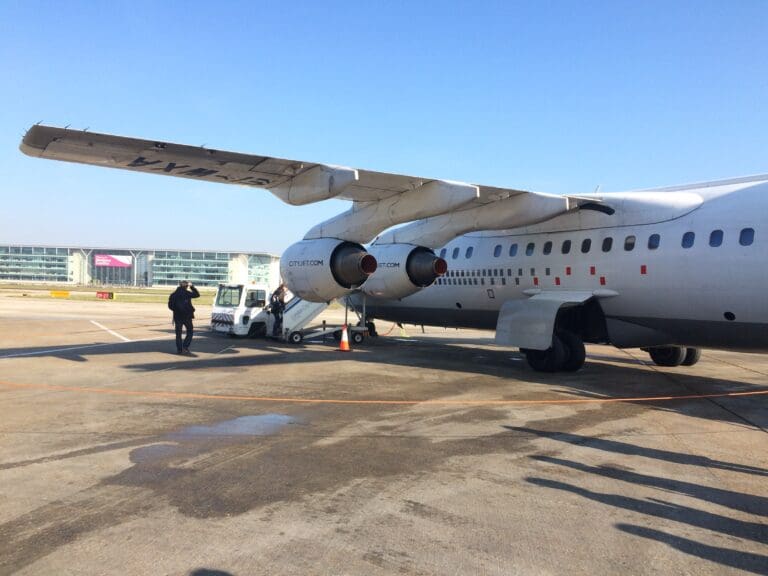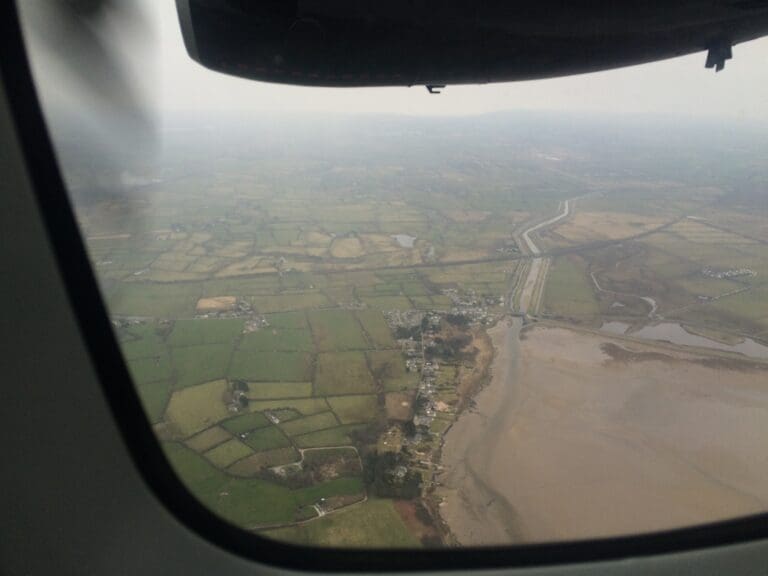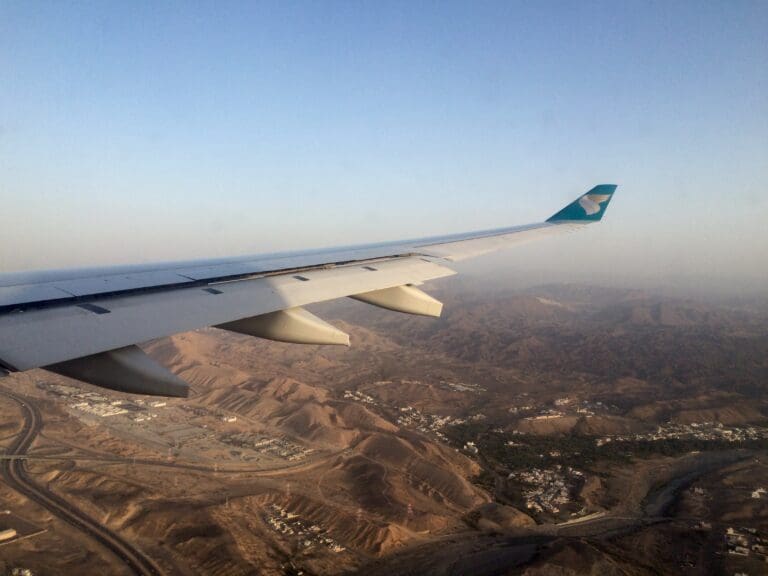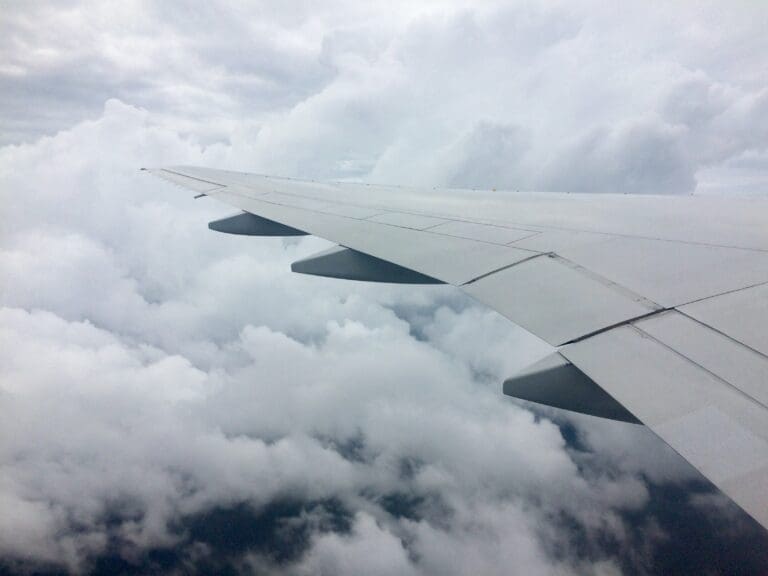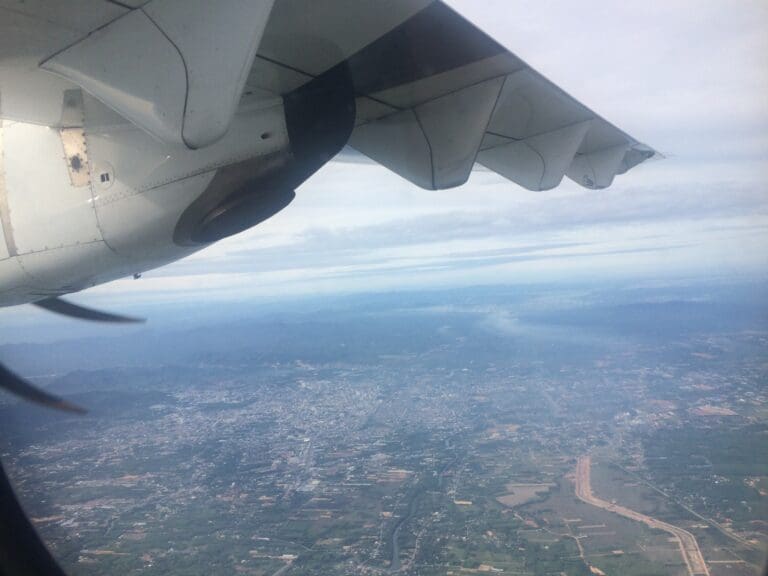A China Southern Nightmare: Beijing to Dubai with a Few Stops Across China
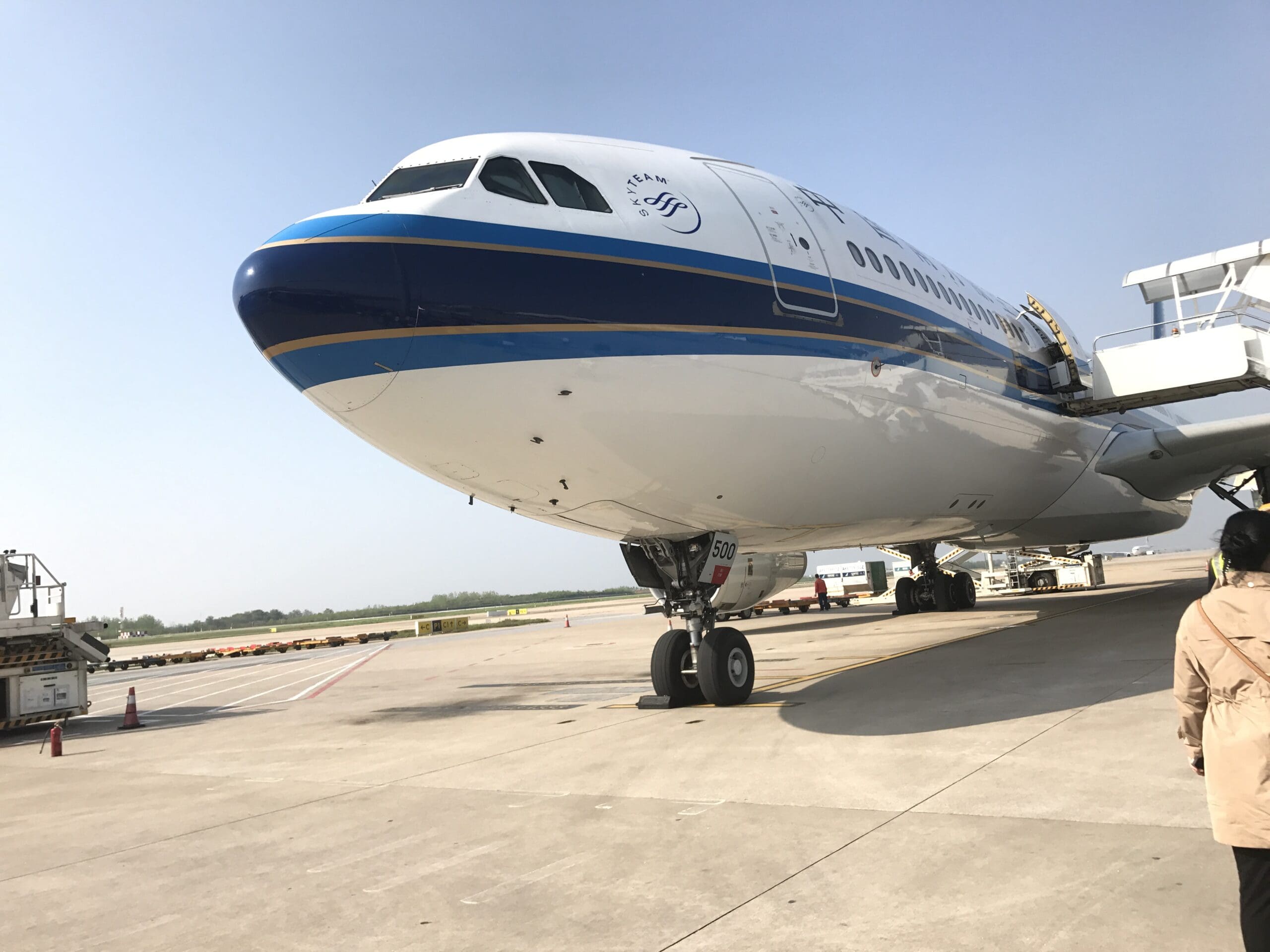
Disclaimer
This flight took place in April 2017 and I have re-uploaded my review as I have moved my blog to a new site.
China Southern Airlines no longer maintain a hub at Beijing Capital Airport and have moved to the newly opened Beijing Daxing Airport. In addition, the airline no longer operates the Shenzhen to Dubai via Wuhan route. Instead, China Southern Airlines operates two separate flights that run directly from Shenzhen and Wuhan to Dubai. As per Winter 2024 schedules, these are operated by Airbus A330-300s and Boeing 787-8 Dreamliners respectively.
You can read all the background information to this trip, and a review of my Korean Air Boeing 777-200ER operated hop from Seoul Gimpo to Beijing Capital by clicking here.
To offer a very brief summary, living in Seoul and needing to get to Dubai for a family reunion, I had been lured in by a cheap China Southern Airlines fare. The outbound portion involved flying from Seoul Gimpo to Beijing Capital onboard a Korean Air Boeing 777-200ER. I would then have around three hours to pass through immigration and connect to a China Southern Airlines operated service to Urumqi. Once there, I would pass through immigration again and head southwards on one of China Southern Airlines’ soon-to-be-retired Boeing 757-200s – a rare gem in East Asia! Sadly, all had not been plain sailing and five days before my flight I received a mystery call informing me that my flight from Beijing to Urumqi had been cancelled and that I had been rebooked. Strangely, I had been rebooked onto a service from Beijing to Urumqi that departed a day after my flight from Urumqi to Dubai, and as a result I ended up having to call up China Southern Airlines’ call centre who seemed to be bamboozled by my itinerary. Fortunately, after two calls and a significant amount of stress, I was rebooked onto a flight from Beijing to Urumqi that departed just five minutes after the cancelled service.
Unfortunately, congestion in the Chinese skies meant that my flight from Korea was subject to an air traffic slot delay, and I touched down in Beijing with just over thirty minutes to go meaning that there was no chance that I could make my connection to Urumqi. On the plus side, a helpful and friendly Korean Air ground agent was already waiting for me on the jet bridge and escorted me to immigration and to China Southern Airlines’ ticket desks so I could be rebooked.
Following a fairly long walk from the gate, I arrived at Terminal 2’s large immigration hall. Once there, I joined a fast moving queue and managed to pass through immigration in no more than fifteen minutes. Whilst this was a long wait compared to say the likes of Yantai, this was far better than a number of previous experiences waiting in immigration queues at some of China’s larger airports. Once I had officially entered China, I was rejoined by the Korean Air staff member and with no luggage to collect, we soon arrived at China Southern Airlines’ ticket desk. There, I handed over my passport and original itinerary to the agent behind the desk who appeared to be working tirelessly, juggling their phone and radio whilst furiously typing away. Unfortunately, rebooking my flights to Dubai did not appear to be any sort of easy task and it took a total of thirty minutes before I received any sort of update, during which time I was permitted to sit behind an empty desk. After disappearing with my documents for a worrying amount of time, eventually the agent returned and advised me that I could either fly via Guangzhou or Shenzhen. The Shenzhen option would see me depart Beijing at 2100 that evening and arrive in Dubai at 2055 the following day onboard a China Southern Airbus A330 with a short stop in Wuhan. Meanwhile, the Guangzhou option would allow me to leave Beijing earlier that day, however I would arrive into Dubai a little later. With this considered, I decided to go for the Shenzhen option and after making this decision, I was asked for my email address.
Following another twenty minutes of waiting, my new ticket was handed to me along with my passport and I was free to wander off. Carrying a minimal amount of Chinese Yuan, and with China Southern Airlines providing neither any sort of refreshment voucher or accommodation, I ended up staying in the landside portion of the terminal for my long and unexpected stay in the Chinese capital. I thus spent the much of the day doing little bar milling about, hoping that I would be provided with a hotel room in Shenzhen as had happened with China Eastern Airlines when long delays had left me stranded in Kunming for a night a couple of months earlier. Seeking some reassurance, I decided to ask about this at the China Southern Airlines information desk in the terminal. Unfortunately, no clear answer was given and I was instead advised to ‘ask the staff in Shenzhen’.
As much as I may be a fan of airports, with minimal views of the action outside, the hours passed rather slowly and eventually, with three hours to go until departure, I attempted to check-in for my flight. Unfortunately, seeing as the check-in machines failed to recognise both my passport and ticket number, I was left with no choice but to join the long and disorderly queues leading up to China Southern Airlines’ check-in desks. After around half an hour, I reached the front of the queue, however much to my dismay, I was informed that my flight to Shenzhen would depart an hour behind schedule and was thus advised to return in an hour’s time. An hour later, I re-joined the queue and upon making it to the front, I was told the exact same thing! Eventually, at 2000, an hour before the flight’s original departure time, I tried my luck for the third time and joined the queue, and after fifteen minutes of shuffling forward, a rather weary-looking check-in agent checked me in for the service down to Shenzhen and handed me a China Southern Airlines branded boarding pass.
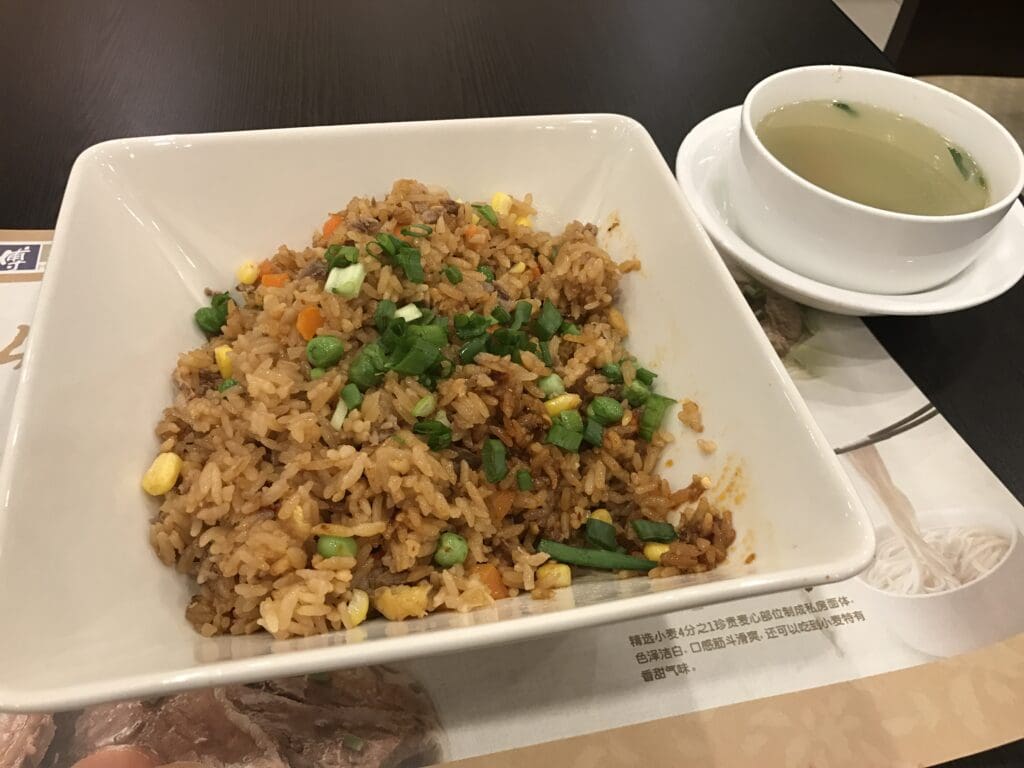

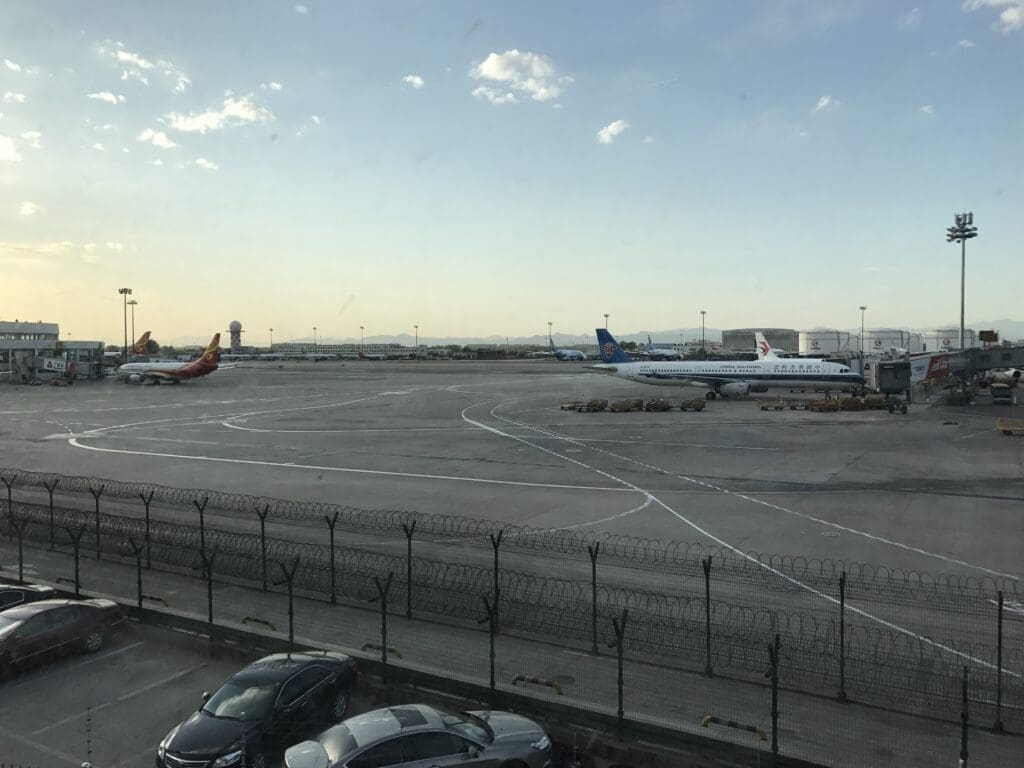
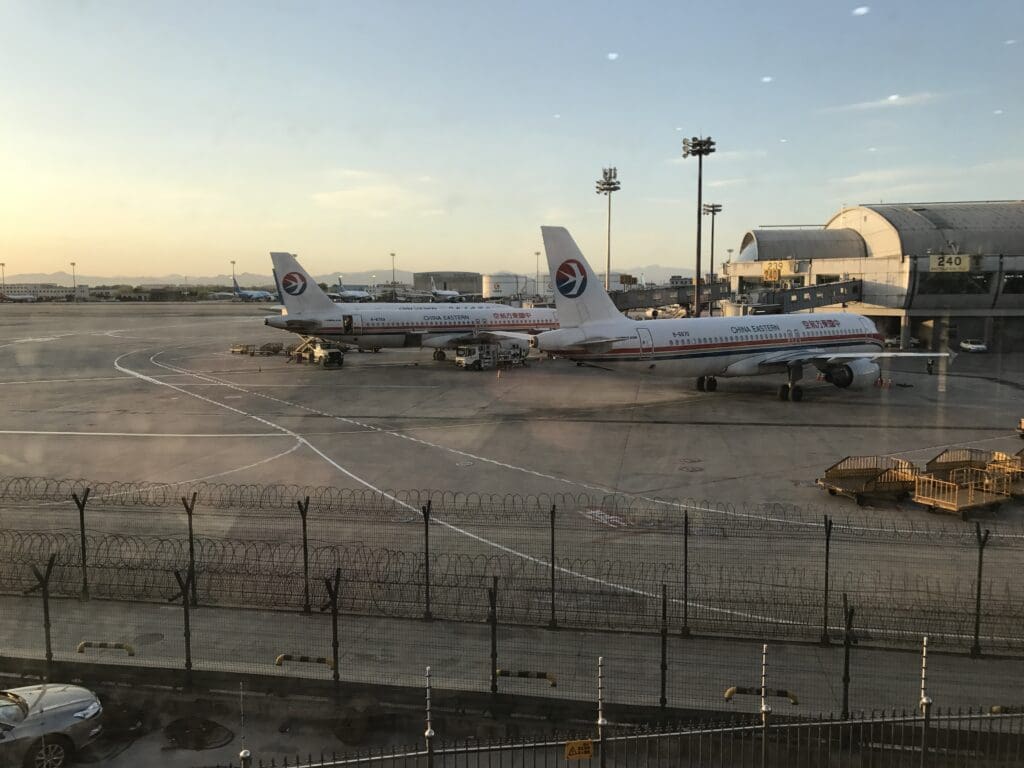
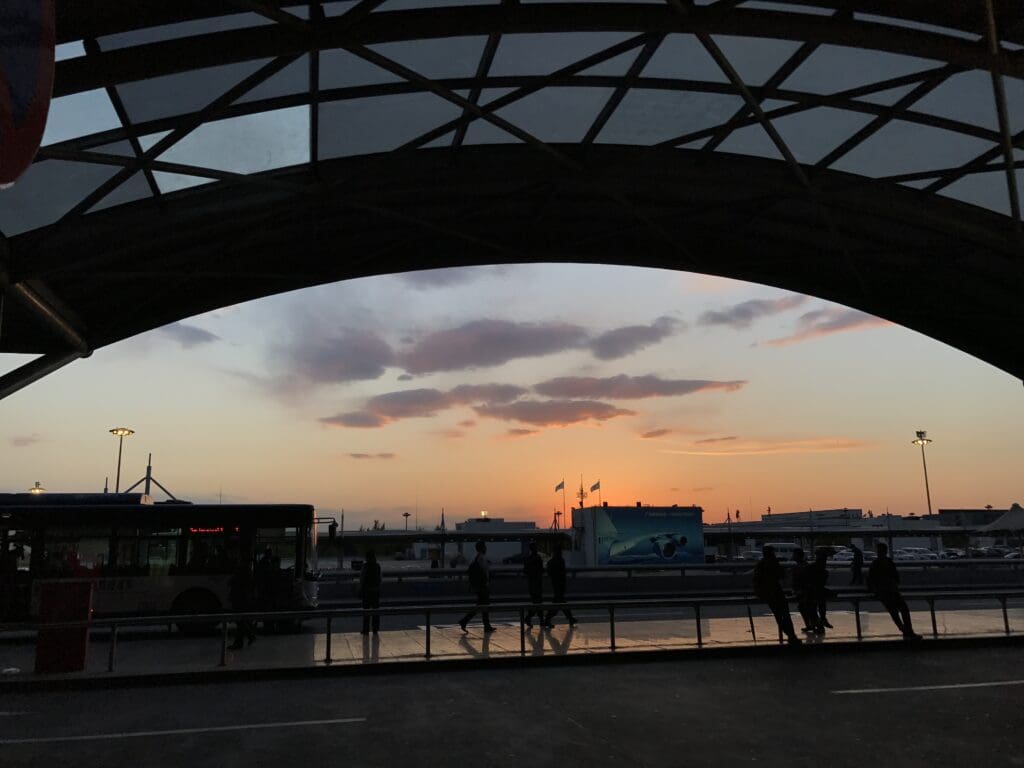
By the time I had checked in, I was rather fed up with the landside portion of the terminal and thus made a beeline for the entrance to security. There, my passport was checked and my boarding pass was scanned and stamped before I entered the security check. As is usually the case at Chinese airports, security was a thorough and comprehensive process, but with an army of staff on hand, this did not take too long and I soon arrived in the airside portion of the terminal. Seeing as both my boarding pass and departure boards still displayed the 2100 Shenzhen service to be departing on time, I thought it best to play things safe and head to the gate just in case this was the case. Upon arriving there, I was greeted by the sight of crowds whilst a China Southern Airlines Airbus A321 could be seen waiting in the darkness outside. As is usually the case in East Asia when a flight is delayed, a sign had been erected at the gate informing passengers of the delay, noting that this was due to bad weather and stating that the new departure time was unknown.
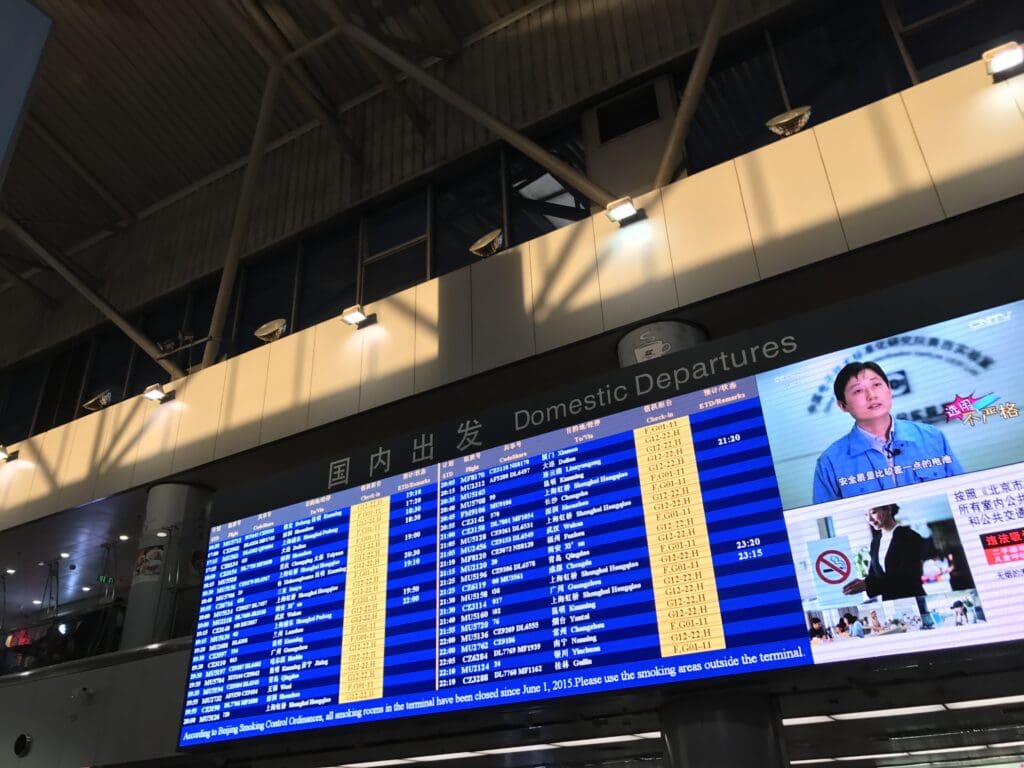
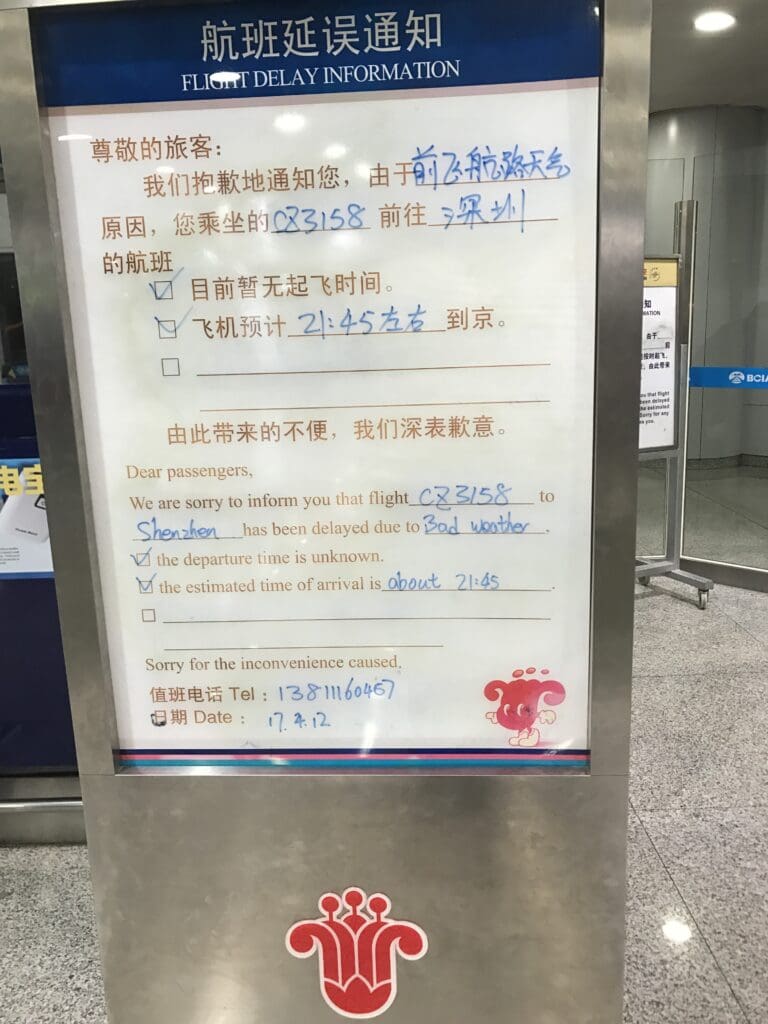
After this short stop, seeing no reason to linger around the crowded gate area, I decided to go for a wander around. Whilst Terminal 2 pales in size to the humongous sprawl of Terminal 3, this is still fairly large and is the home of China Southern Airlines’ operations in Beijing, also serving other Chinese SkyTeam carriers such as China Eastern Airlines, Shanghai Airlines and Xiamen Air, as well as both overseas SkyTeam and non-allianced airlines. Most famously, this is the starting point for many of those heading to North Korea, with this hosting Air Koryo’s Tupolev Tu-204 operated Beijing services. Inside, this contains a wide variety of shops and eateries, including major international chains such as McDonalds and Starbucks just to name a few. Whilst the terminal had initially been rather busy, as time passed, one by one aircraft departed to destinations across China and as the evening progressed the terminal emptied out.
Eventually, I returned to the gate, and by 2305, a little over two hours after the flight’s scheduled departure time, an irate crowd of passengers, angered by the delay and lack of information regarding this had formed, whilst a single staff member had been placed to deal with the chaos. Eventually, at 2340 a tub containing snacks and drinks was wheeled out and a crowd soon formed around this, however, by the time I reached this only several small cartons of apple juice remained. Whilst this offering hinted that a further delay to the flight could be expected, much to everyone’s surprise, minutes later and without any sort of announcement, boarding finally commenced!
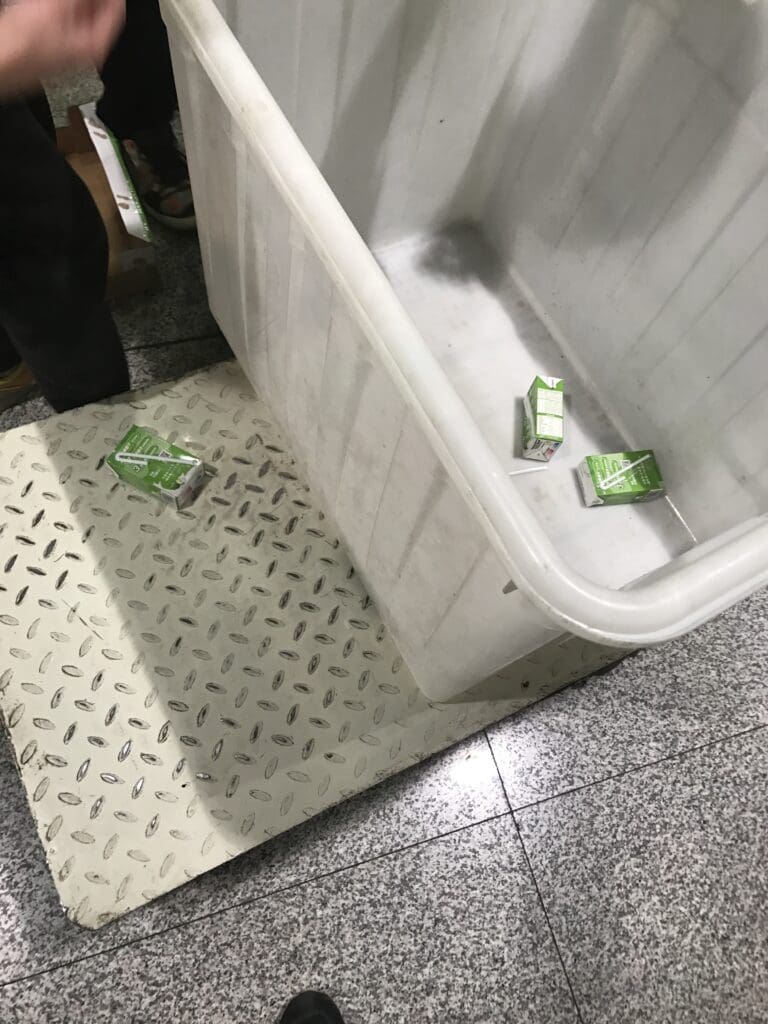
That night, I would find myself travelling to Shenzhen onboard Airbus A321-231 B-1846. Assembled at Airbus’ Hamburg Finkenwerder plant, this particular aircraft made its first flight with the test registration D-AZAS in July 2014, before being delivered to China Southern the following month. Since then, the aircraft appeared to have had a rather uneventful career, operating a mixture of domestic services across China, alongside international flights to destinations across East Asia.
After having my boarding pass scanned, I wearily shuffled down the jetbridge, and after eleven hours trapped in the confines of Terminal 2, I was delighted to finally step into the forward galley. Likely as tired as many of the passengers, once onboard, I failed to receive anything by means of a greeting from either of the two flight attendants standing there who instead simply watched passengers as they boarded without making a sound. Turning right, I soon entered the Airbus’ small Business cabin, which consists of blue-fabric-covered recliner seats in a 2-2 configuration, before I entered the Premium Economy cabin.
As I trundled down the aircraft, I received a distant and subdued welcome from another flight attendant and soon arrived at my seat in the middle of the aircraft. As is the case onboard most China Southern Airlines aircraft, this seat was covered in a dark blue fabric on which a pattern of gold diagonal stripes could be seen. Meanwhile, each seat came with a fabric antimacassar that featured China Southern Airlines’ motif alongside the SkyTeam logo. As seems to be the norm in China, despite the airline’s status as a full-service carrier, several advertisements could be seen throughout the cabin of the Airbus and a sticker advertising Ping An Securities could be seen on the underside of the tray table. Given the age of the aircraft, unsurprisingly I failed to spot any notable signs of wear and tear around my seat, whilst the aircraft appeared to have been cleaned to a high standard during its long turnaround in Beijing. Turning to the seat, this was reasonably soft and comfortable and featured an acceptable amount of legroom. Finally, aside from the safety card and a sick bag, the seatback pockets contained various publications, including the Civil Aviation Authority of China’s Chinese language-only magazine, and a copy of the Chinese version of Men’s Health.
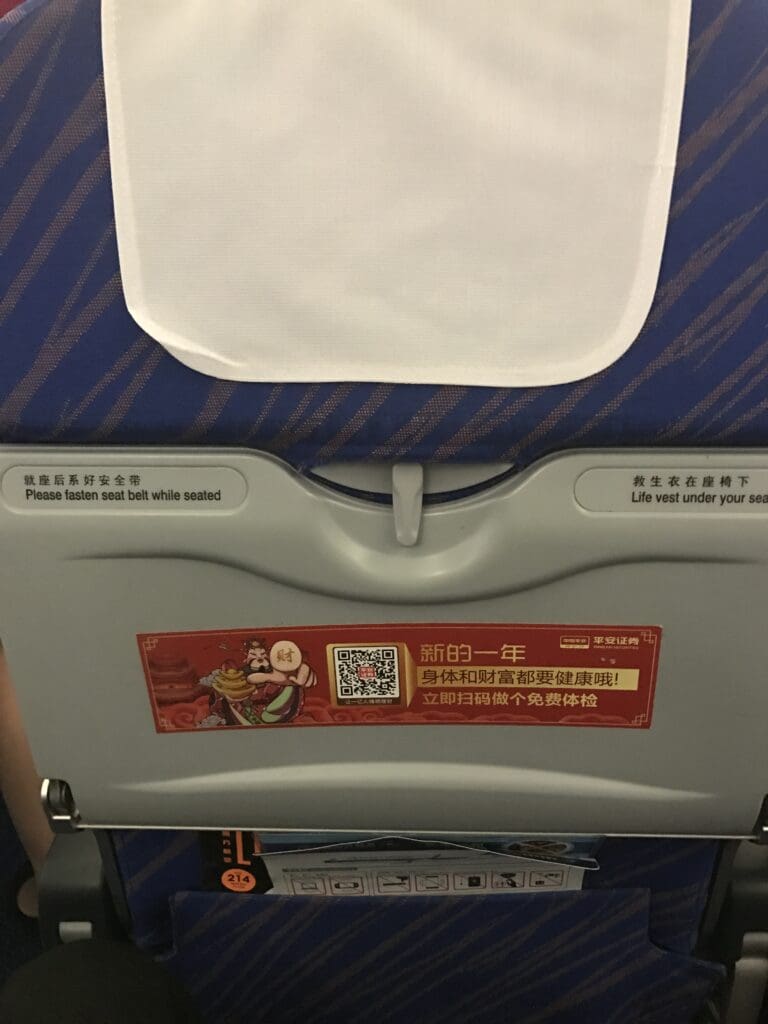
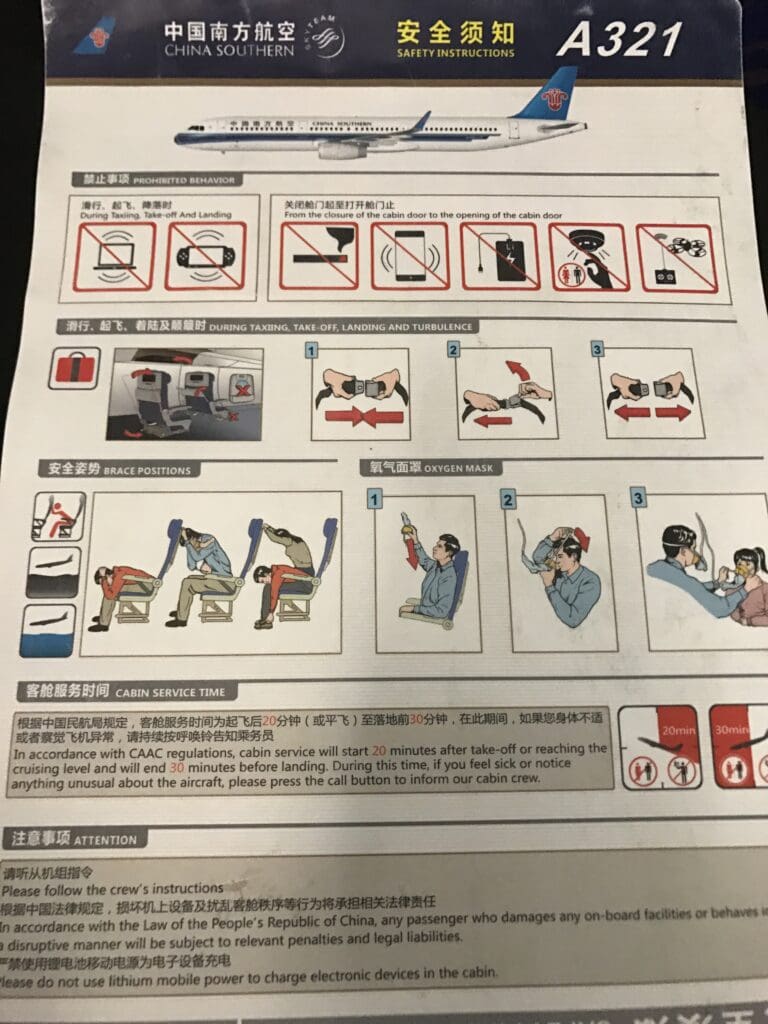
With all passengers perhaps desperate to head southwards to Shenzhen, boarding was a speedy affair and by 2350, the final passenger made it onto the aircraft. Much to my delight, the two neighbouring seats remained empty and the total load in Economy appeared to be no more than 40%. A few minutes later, the traditional music that had accompanied boarding came to an end as the Purser performed a welcome announcement in Mandarin and English, before crew members took to the aisle, pointing out the nearest exits and how to use the seatbelts. After this, the overhead screens dropped into position and began to broadcast China Southern Airlines’ long safety video.
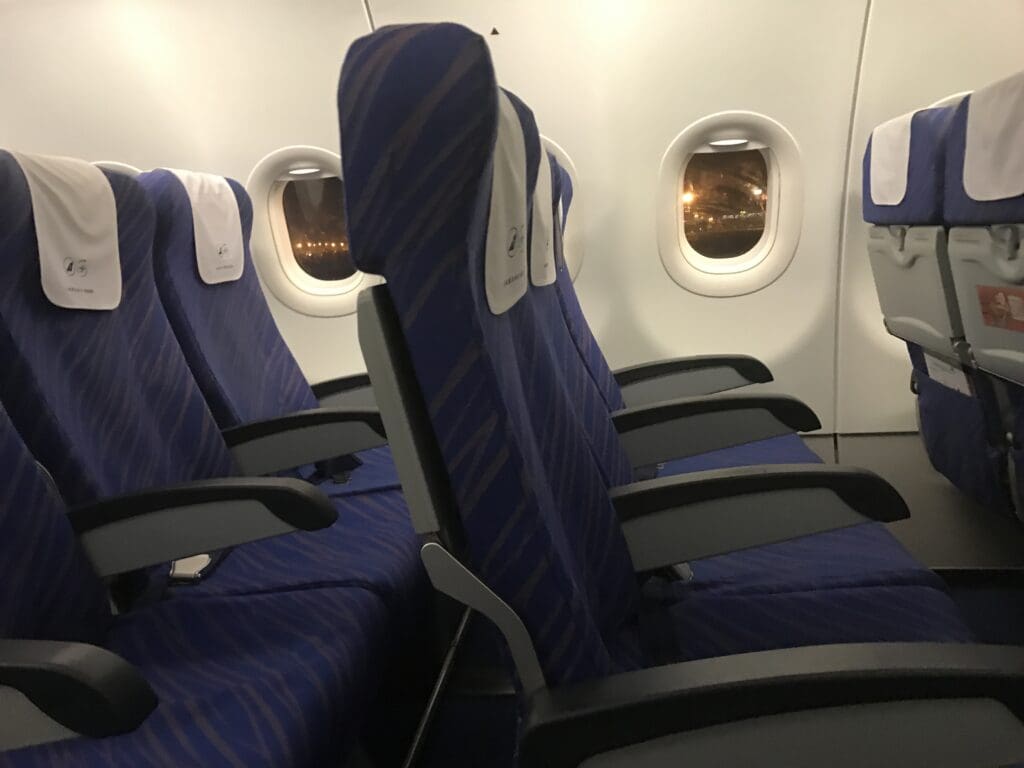
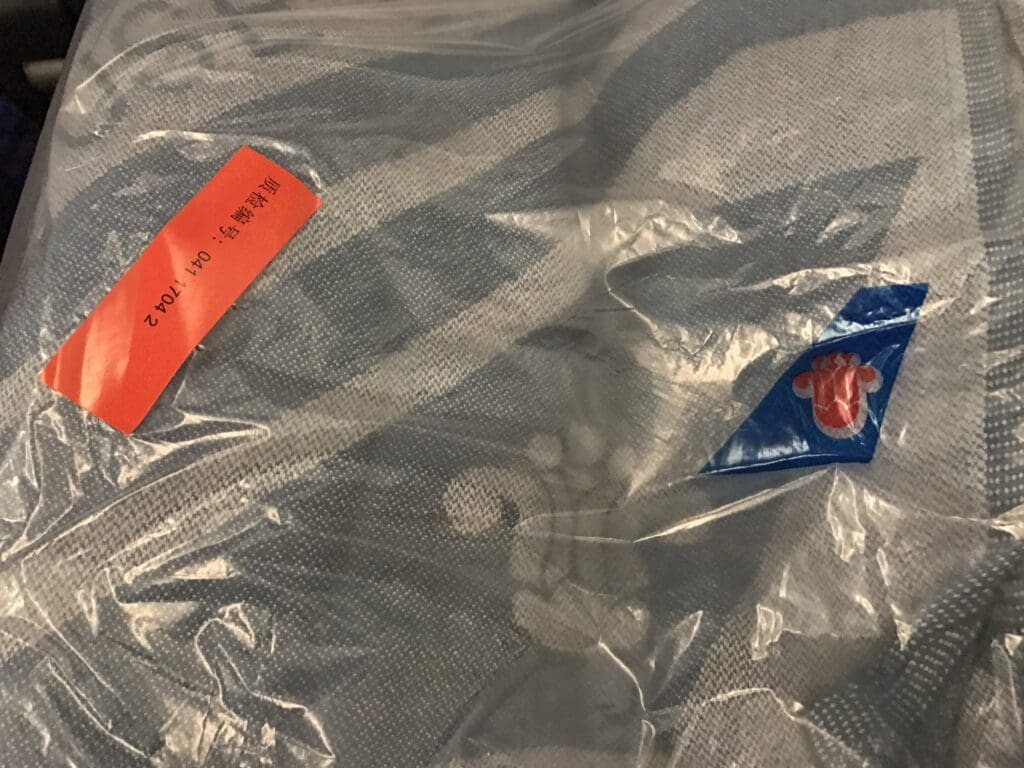
With everything serving to indicate that we would soon depart, I was a little surprised to find that by the time the long safety video had run its course, we were still firmly in position at the gate and yet to commence our flight down to Guangdong. Eventually, after around fifteen minutes of waiting, the Purser advised passengers that the flight would not depart for at least another thirty minutes owing to air traffic control delays. During this wait, the overhead screens played a series of advertisements before broadcasting the same Chinese film that had been shown on my China Eastern Airlines flight from Shanghai Pudong to Okinawa earlier in the year. Meanwhile, the crew passed through the cabin, first handing out packaged blankets before offering passengers a selection of soft drinks from a tray.
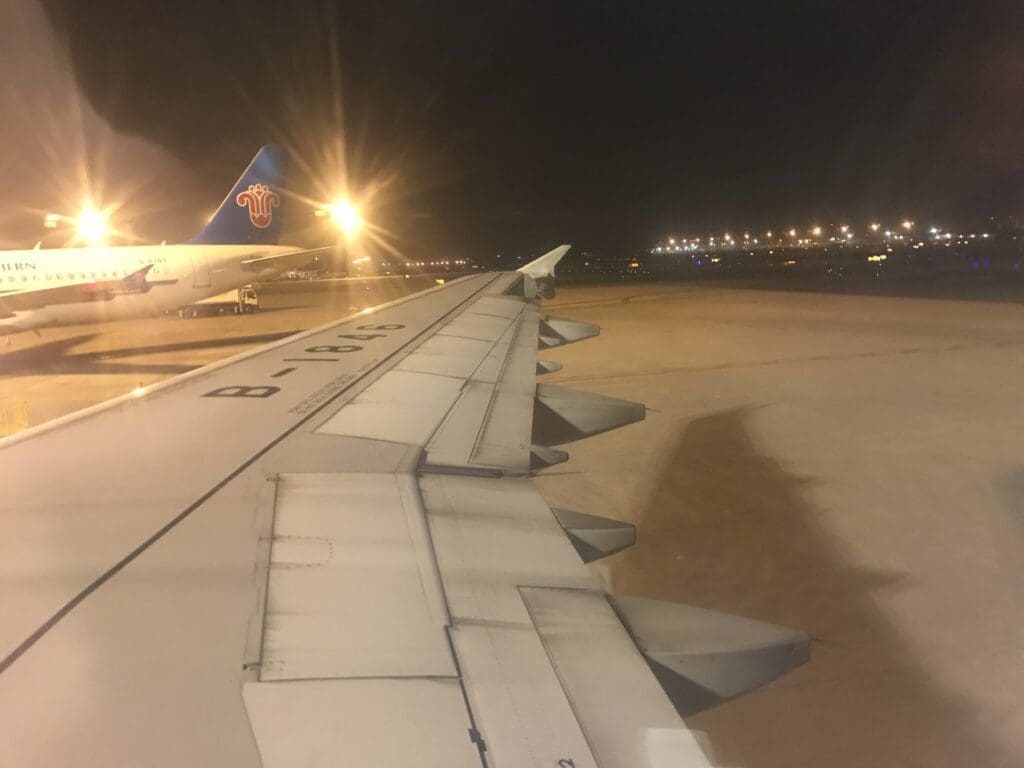
Like many passengers, as we waited I drifted off to sleep, and at 0100 on the dot, I was suddenly woken up by a fairly notable jolt as the aircraft commenced its pushback. Once this had been completed and the aircraft came to a halt, the Airbus’ two International Aero Engines V2533-A5 hairdryers spooled into life with plenty of whirring. Once these had powered up and the flaps had falled into position, the aircraft commenced its long taxi to the end of Runway 36L whilst inside the cabin the flight attendants undertook a final check to ensure that all was secure and in place for our departure. Around fifteen minutes after commencing our taxi, the aircraft arrived at the end of the runway where were were required to wait for a China Southern Airlines Airbus A320 to touchdown and vacate the runway before being allowed to proceed onto this.
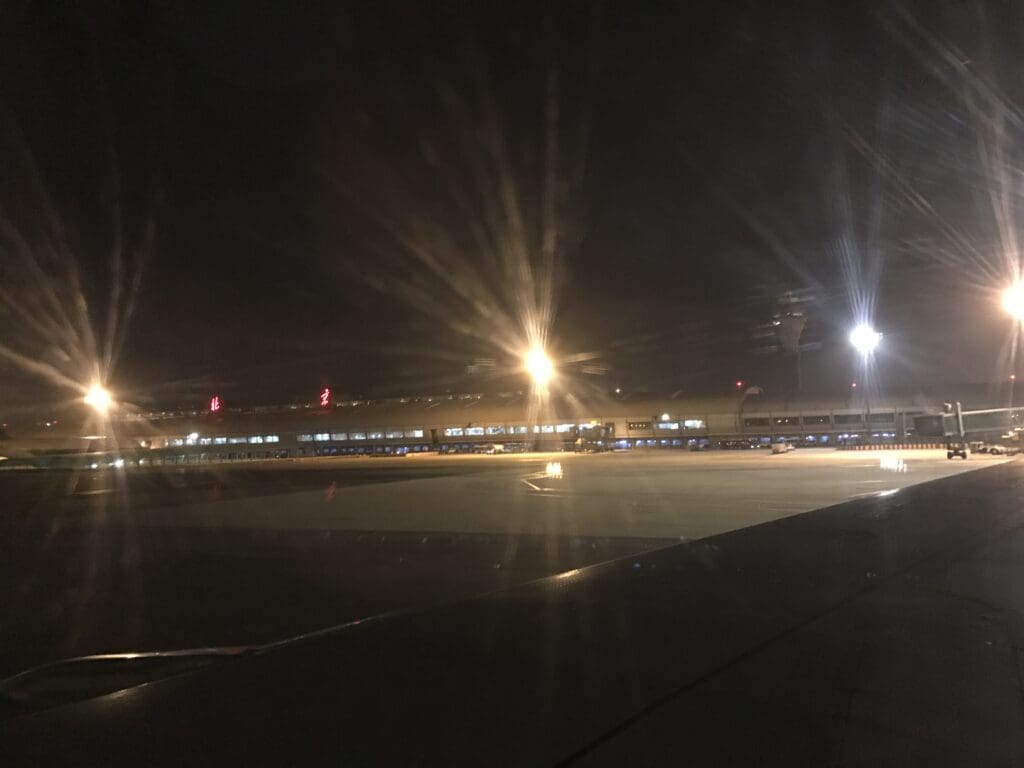
Eventually, over four hours behind schedule, the Airbus taxied onto the runway and before a gentle rolling takeoff, travelling quite some distance down the long runway before rotating upwards and commencing what seemed to be a shallow climb through the skies around the Chinese capital. In accordance with Chinese regulations, despite smoothly cutting through the night skies, the seatbelt signs remained firmly illuminated and the crew remained in their seats until we had levelled off at our cruising altitude. After thirty minutes, the Airbus reached its cruising altitude at which point the cabin lights were turned on at full blast – with no sort of moodlighting installed onboard this aircraft.
Perhaps realising that most passengers simply wanted to sleep, once released from their seats, the flight attendants took to the aisles and commenced the evening meal service. This was more of a breakfast offering and consisted of a snack box containing bread, a croissant shaped pastry (although by definition, this was not technically a croissant), a packet of pickled vegetables and a plain yoghurt. Whilst this is definitely more substantial than most airlines would offer back in Europe, this lacked the hot meal which usually accompanies these boxed on Chinese domestic flights. One these boxes had been distributed, the crew passed through the cabin undertaking a drink round before the cabin flights were dimmed and once again, most passengers drifted back off to sleep.
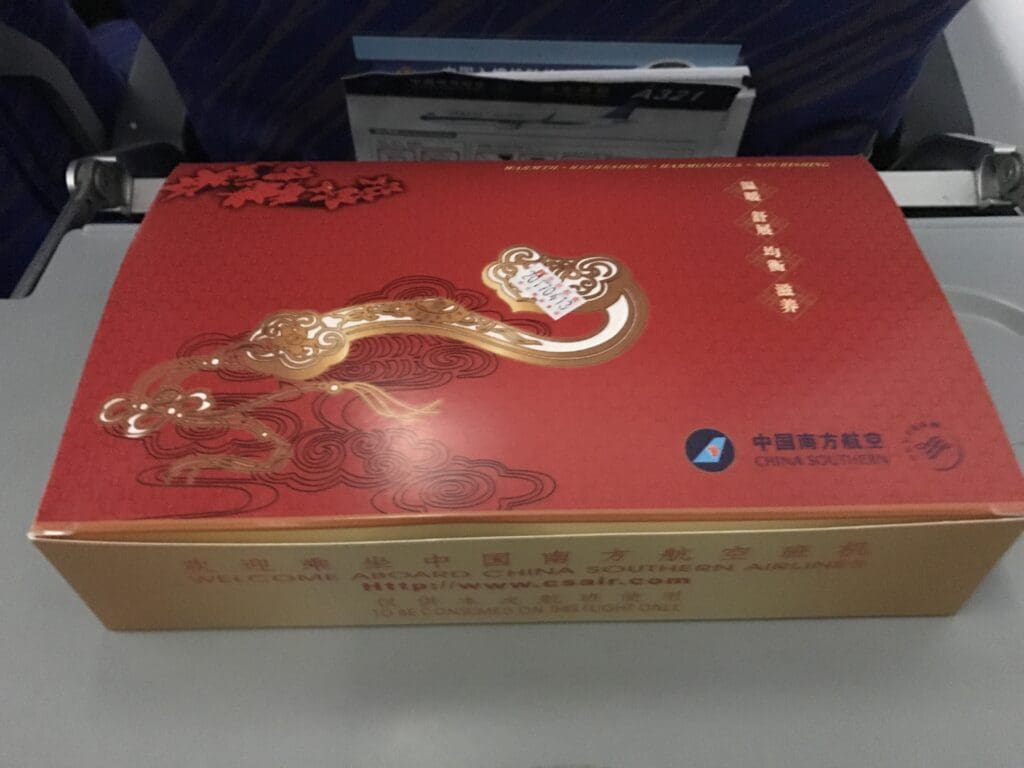
As the aircraft slowly edged down towards Southern China, the aircraft began to be thrown about a little by the occasional bout of fairly significant turbulence. However, this did not disrupt my sleep too much and a couple of hours or so after taking off from Beijing, I woke up just as the Purser was performing their pre-arrival announcement. This consisted of a word of thanks for flying with China Southern Airlines, an apology for the delay and the usual instructions and warnings regarding seatbelts, seatbacks, tray tables and window shades. Immediately afterwards, the army of flight attendants took to the aisle and had their work cut out waking up passengers and ensuring that all was secure before the aircraft began its fairly bumpy descent into Shenzhen.
Looking outside, a combination of the darkness, clouds and haze meant that little could be seen of the southern province of Guangdong, with the aircraft’s flaps and landing gear extended whilst the Airbus was still in the clouds. At 0412, the ground appeared below and moments later, the Airbus whizzed over Shenzhen Airport’s perimeter fence before making a rather bouncy touchdown on Runway 34 almost three hours after taking off from Beijing. This was followed by some gentle braking before we made our way over to a stand at the large and modern terminal. Looking outside, whilst I was a little too weary to planespot, rows and rows of aircraft operated by airlines from across China could be seen, alongside a rare Boeing 737 Classic freighter operated by an Indonesian carrier.
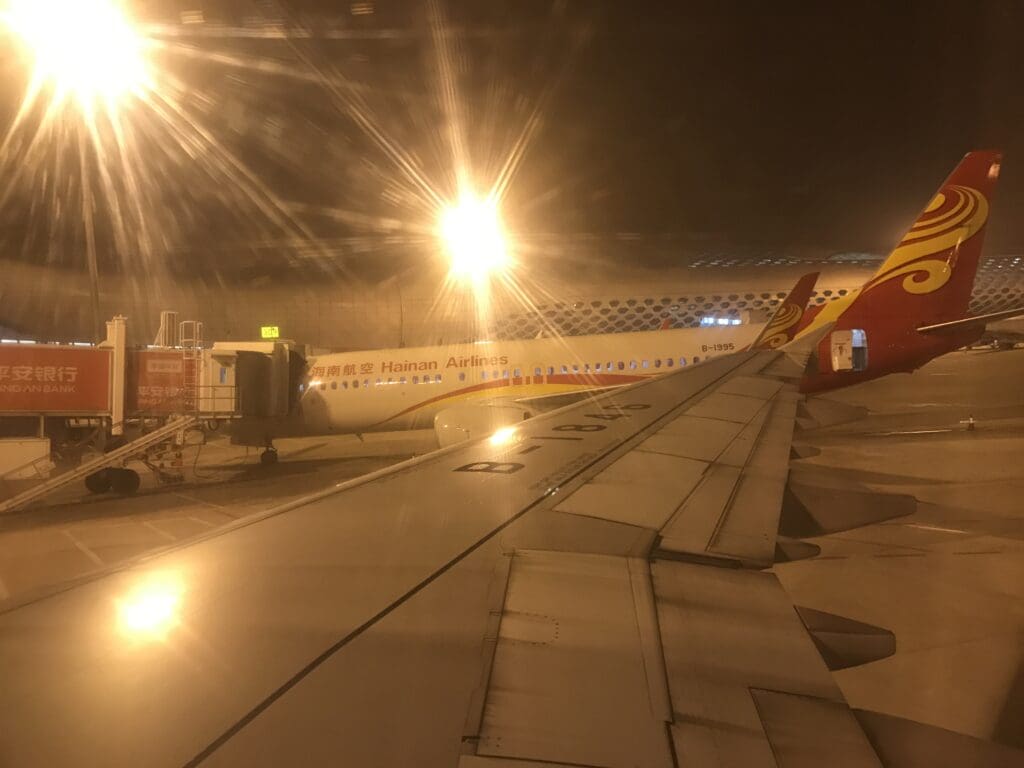
Seeing as the aircraft’s next sector would take it southwards to Bangkok, that morning the aircraft pulled in to an international gate. With things running like clockwork, once there, the jet bridge was soon positioned up to the aircraft and disembarkation commenced a few short minutes after coming to a halt. Soon, I collected my belongings and headed through the aircraft, thanking the somewhat cold crew before stepping off the aircraft. Even though a jet bridge was connected to the aircraft, seeing as we could not head straight into the international portion of the terminal, as soon as we stepped off the aircraft we were all ushered down the jet bridge’s steps and onto an awaiting bus that would shuttle us to the domestic arrivals area.
Following a quick sprint, I made my way into the domestic arrivals hall and I soon spotted a China Southern Airlines staff member holding a sign saying ‘transit’. Although this staff member didn’t really speak English, thanks to the magic of online translation apps, I was able to convey the message that I was heading onwards to Dubai. Following a short wait, I was escorted through Shenzhen’s spacious and modern arrivals area and once landside, I was advised to wait ten minutes whilst he arranged transport to a local hotel. True to his word, he returned ten minutes later and bundled me into waiting car which soon sped off. Uncertain as to exactly where I was heading, I wasn’t expecting any sort of great luxury. When I had ended up stranded overnight in Kunming, China Eastern Airlines had put me up in a backstreet hotel and I was expecting a similar arrangement in Shenzhen. After a few minutes, the car pulled up to a neon-lit and shabby facility on the fringes of the airport. This turned out to be China Southern Airlines’ local accommodation which seemed to primarily host crew members on layovers in Shenzhen, as well as passengers like me who ended up being stranded for the night. Once inside, the sole staff member manning the reception desk requested to see my boarding pass and passport, upon seeing the latter I was advised that a bus would come to collect me five hours later at 1000 before I was handed a key to my room. Whilst the hotel was a little old fashioned, this was perfectly acceptable for a short stay and, rather interestingly, almost everything inside this was branded with China Southern Airlines’ logo.
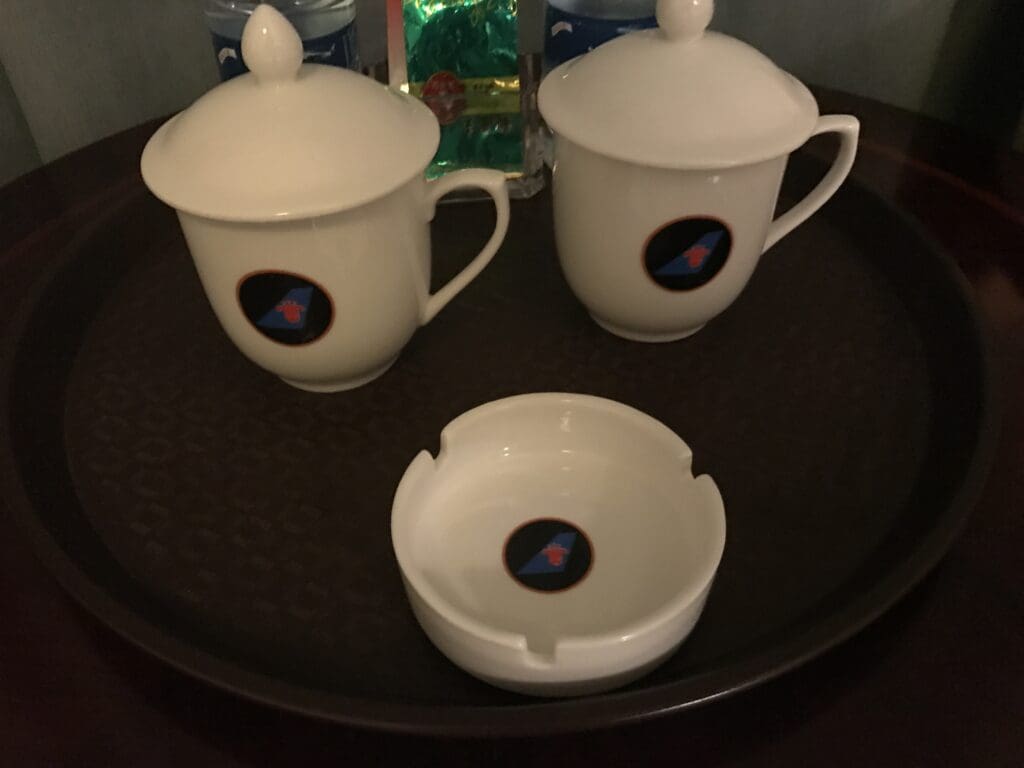
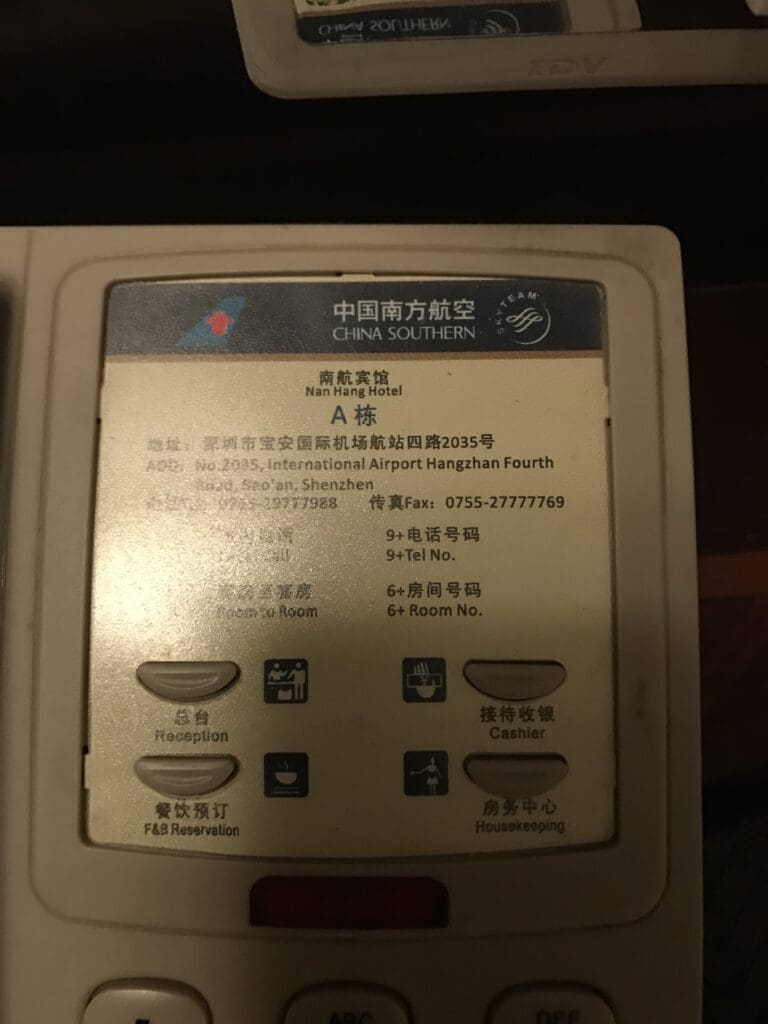

Following much needed four hours of sleek, I woke up and began to prepare for another long day of travel. Seeing as this hotel primarily catered to China Southern Airlines’ staff, there was no sort of restaurant and thus no expansive buffet breakfast that I could enjoy before heading off to the Middle East. Following a quick shower, I left my room and made my way to reception where I handed in my key and making my way outside. Much to my delight, at 1000 on the dot, what seemed to be a China Southern Airlines crew bus rocked up outside and I boarded this for a speedy ten minute journey to the airport. Soon, the bus pulled up outside Shenzhen Airport’s massive and modern check-in hall, where I disembarked and made my way inside.
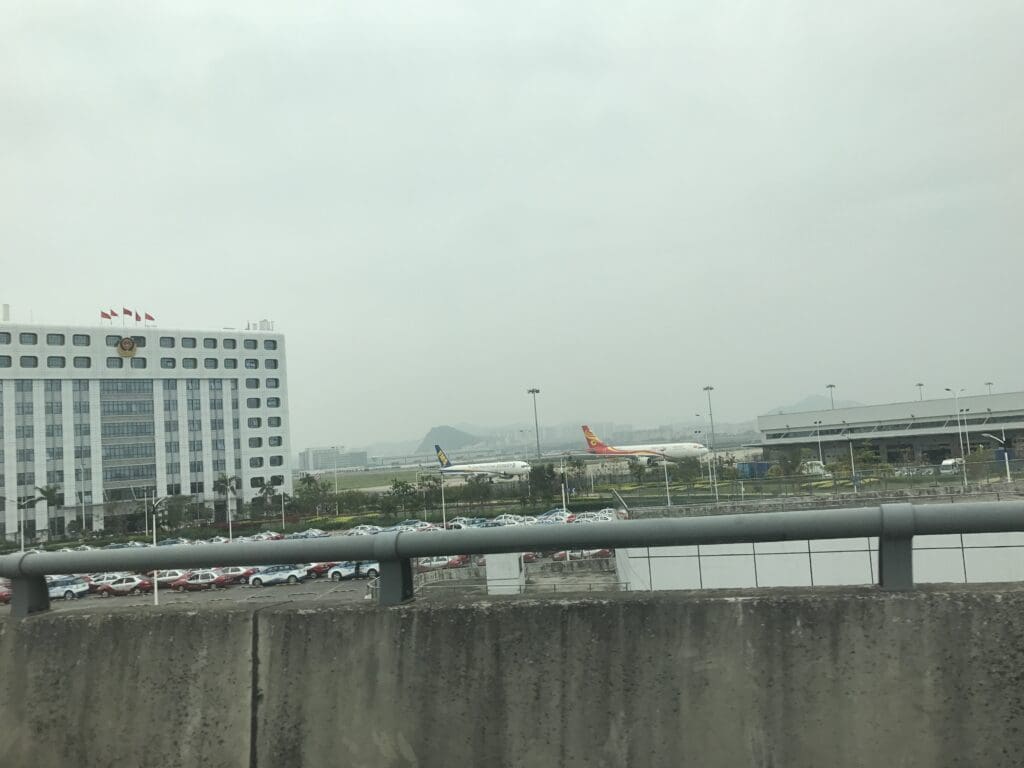

With an endless stream of flights departing to destinations all over China and beyond, unsurprisingly, this was rather busy. However, being a major hub for China Southern Airlines, plenty of the airline’s branding could be seen dotted around, alongside that of hometown airline Shenzhen Airlines. Whilst the final destination of my flight from Shenzhen was of course Dubai, seeing as this service makes a stop in Wuhan, I was uncertain of whether I should check-in at China Southern Airlines’ domestic or international check-in areas which were located in different parts of the terminal. After consulting with one of the airline’s ground staff, I was advised to head to the international check in zone. Given the long line of passengers leading up to China Southern Airlines’ domestic desks, I was rather happy about this, with the international check-in area being almost entirely devoid of passengers. Once there, I walked up straight up to a desk and handed over my passport and ticket to the somewhat cold agent. Following the usual typing, a China Southern Airlines boarding pass was printed off and I was handed a card which advised me to pass through security checkpoint 38 at Shenzhen, alongside a red sticker that identified me as a Dubai-bound passenger.

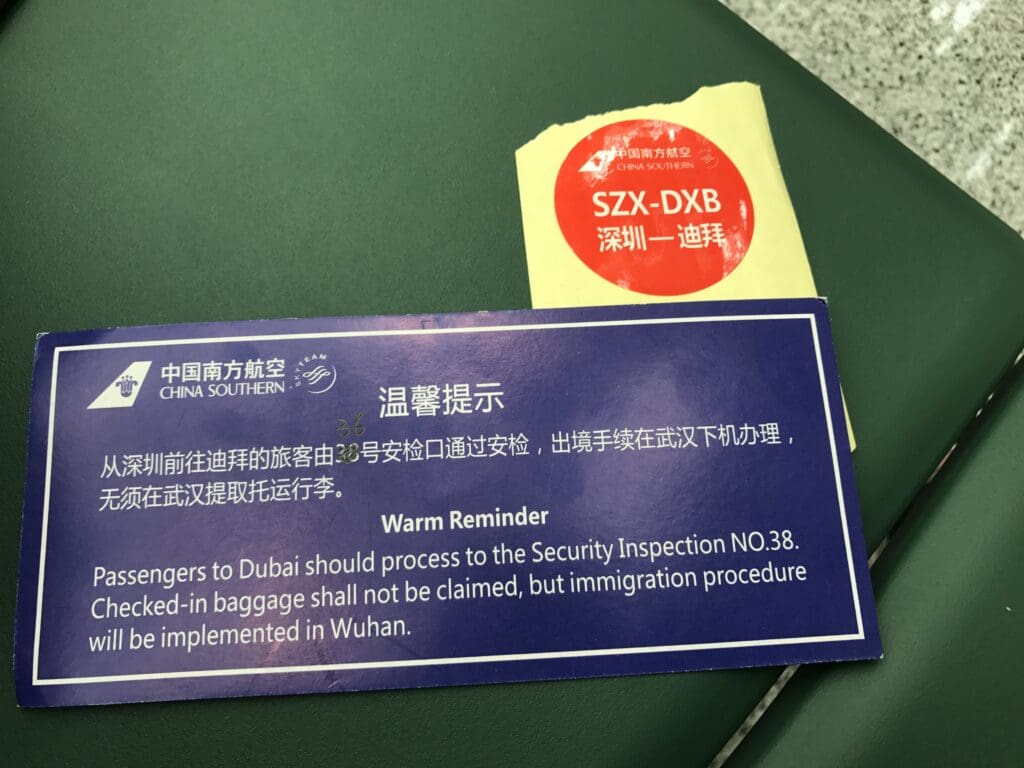
Following the instructions on the card, I made my way to the security checkpoint and was rather surprised to find that this was the airport’s ‘VIP’ checkpoint. Before entering this, I was subject to a boarding pass and identity check, and the agent there seemed to be a little puzzled by my Dubai boarding pass. However, after making a quick phone call, all appeared to be resolved and I was allowed to advance onwards to the empty security checkpoint. Once there, my belongings were thoroughly examined, however, with no need for any additional checks, I was soon allowed to continue onwards to the airport’s large airside departure area. As with the landside area of the terminal, I found the airside area to be large, spacious, modern and clean, with a vast array of shops and eateries on offer for those looking to pass the time before jetting off. One of the more unusual aspects of this terminal were the highly noticeable presence of small birds flying around!

As great as the terminal is, unfortunately, thanks to its design, it isn’t the best for taking photos of the aircraft waiting outside thanks to the presence of colourful glass windows. Looking through these, a wide array of aircraft of all shapes and sizes, ranging from Airbus A319s right up to Air China Boeing 747s could be seen being readied for their next missions, with a constant stream of aircraft coming and going throughout my stay. After wandering around, I took a seat and, all of a sudden I developed a rather sore throat and a runny nose, and I would have to contend with a cold throughout my second day of travel.
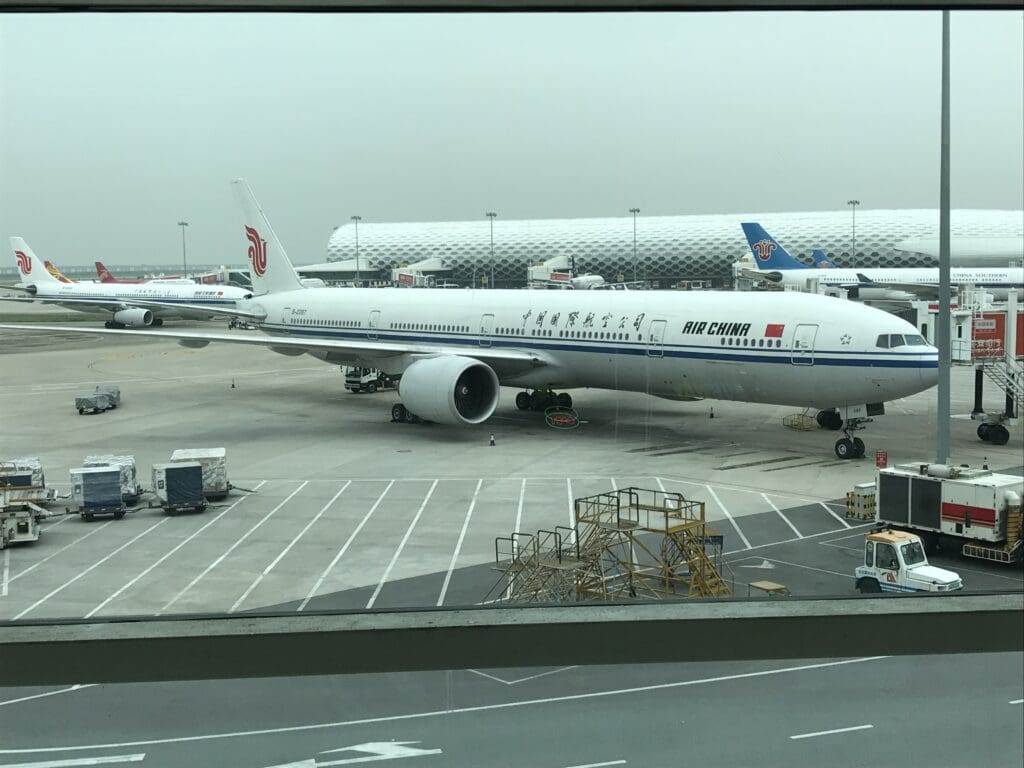
Settling down near the gate, outside this, Airbus A330-343 B-6500 could be seen through the multicoloured glass windows being readied for its 4137-mile journey up to Wuhan and then over to Dubai. This particular aircraft made its first flight from Toulouse Blagnac in September 2008 and had flown for China Southern Airlines since its delivery to the airline at the end of that month. This operated a mixture of short, medium and long haul flights, flying both domestically and internationally to destinations across the airline’s expansive route network.

At 1150, boarding was announced with those in Business and Premium Economy class invited to board the aircraft first, followed by those in Economy. After a few minutes of lingering around the gate, I had my boarding pass scanned and my passport checked before I was free to wander down the jetbridge to the waiting Airbus A330. Following another queue leading up to the aircraft’s L2 door, I stepped into the galley that separates the Business and Premium Economy cabins where I received a polite greeting in Mandarin before turning right and entering the cabin.
Having flown from Istanbul to Urumqi and Beijing to Guangzhou onboard China Southern Airlines’ Airbus A330s in the previous year, I had a good idea of what to expect onboard. Unfortunately, but as expected, despite being a long haul capable widebody, this lacked any sort of individual inflight entertainment screens in Economy, with entertainment instead provided in the form of overhead screens every few rows. Turning to the seats, each sported China Southern Airlines’ blue and gold fabric cover, with each featuring a fabric antimacassar that came with the airline’s logo and an advertisement for the Changyuan Group – a company specialising in the manufacture of electromagnetic materials. Meanwhile, a sticker could be seen on the underside of the tray table which seemed to advertise a company that specialised in marble interiors. Aside from a few marks and scratches, the cabin appeared to be in reasonably good shape and relatively clean. Once I made it to my seat near the rear of the forward Economy cabin, I found this to be relatively soft and offered an acceptable amount of legroom, however, unlike many of China Southern Airlines’ other long haul aircraft, this lacked adjustable headrests and was perhaps not designed for long haul slogs.

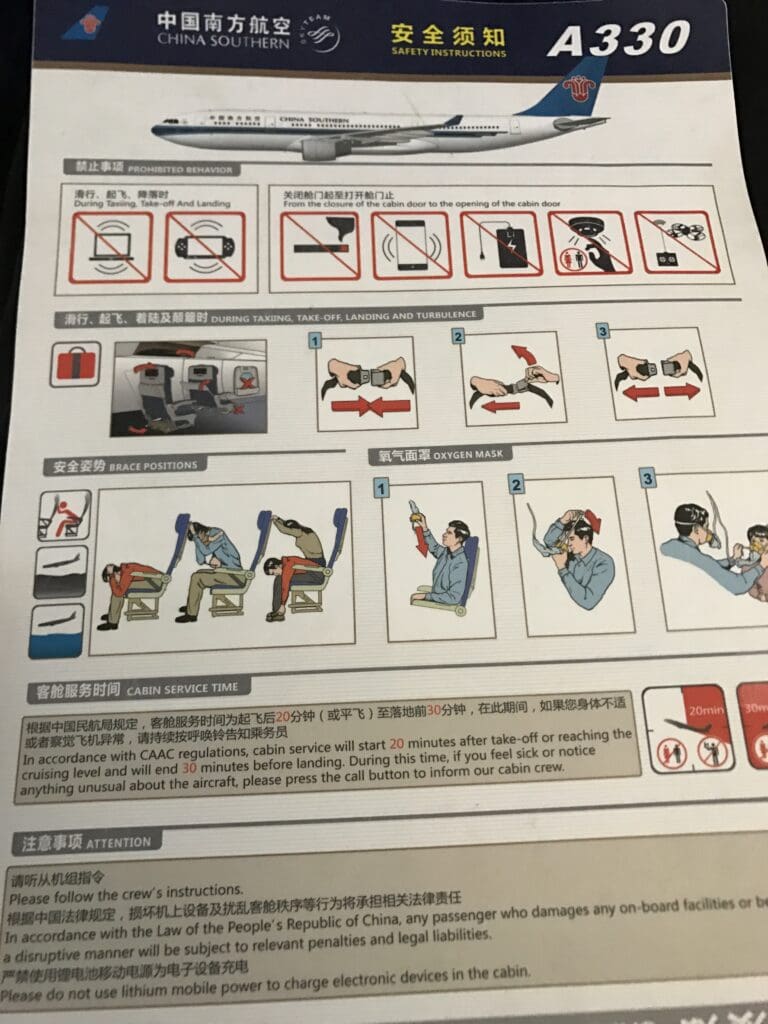
By 1210, all passengers had made it onto the aircraft, with the flight appearing to be near totally full in Economy. At this time the Purser conducted their welcome announcement in Mandarin and English, just as the aircraft commenced its pushback. Once the Purser had completed their welcome, China Southern Airlines’ long safety video was broadcast on the overhead screens as the Airbus’ two large Rolls-Royce Trent 772B-60 hummed into life before we commenced our taxi to the runway. Covering a large area, it seemed to take quite a while to reach the runway, and once there, thanks to the eternal busyness of Shenzhen Airport, the Airbus was required to hold for a few minutes before finally being cleared to depart. That lunchtime, the aircraft commenced what seemed like a long and gentle take-off roll, before sluggishly climbing into the Guangdong skies indicating that we were perhaps heavily loaded.
Once again, thanks to the strict local regulations the seatbelt signs remained illuminated until the aircraft had levelled off at its cruising altitude and the crew remained strapped in to the jumpseats. As soon as we levelled off, the seatbelt signs were extinguished, the crew took to the aisles and the overhead screens fell into position. Whilst no headphones were provided, it appeared that a review of the film, Rogue One was broadcast, followed by a short programme on the Silk Road.
Given the short length of the flight to Wuhan, the crew soon commenced the onboard service. Being a compact service consisting of a warm roll filled with a slice of low quality meat, served alongside a small bottle of still water, this was a speedy affair. Whilst not being the pinnacle of inflight cuisine, having had little to eat that morning and given the length of the flight, this was very much appreciated.
Once I had finished the lunchtime snack, the Airbus could soon be felt commencing its slow step descent towards Wuhan, and, eventually, the gear could be heard and felt falling into position below. Several minutes later, the aircraft returned to earth with a large thud before heading off to a remote stand. After the aircraft’s engines had powered down, an announcement was made requesting all Dubai-bound passengers to remain on the aircraft and await further instructions. Once all those ending their journey in Wuhan had exited the aircraft, the grand total of eight passengers including myself that were heading off to the United Arab Emirates were advised to disembark. However, there was some confusion upon reaching the front of the aircraft when passengers were advised by a crew member to head back to their seats. Following a two minute wait in the aisle, eventually, those bound for Dubai were permitted to exit the aircraft and I soon headed down the set of airstairs into the warm Wuhan sunshine before boarding a luxury bus.
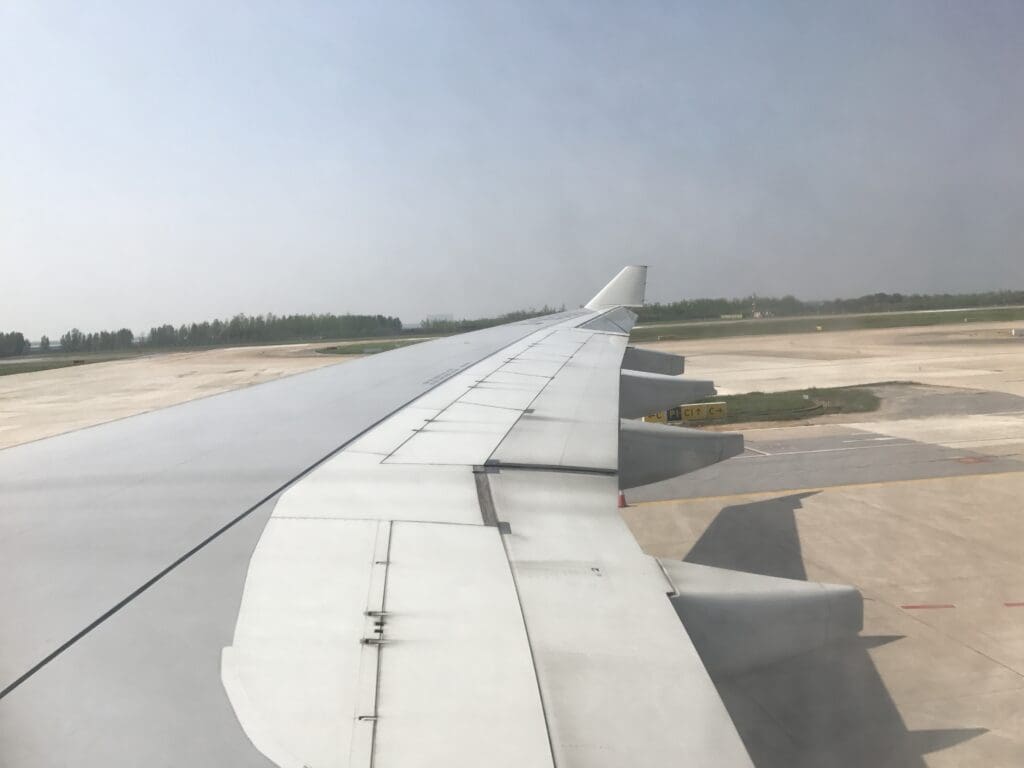
On the other side of the apron, Wuhan’s large and new terminal could be seen where a sleek China Southern Airlines Boeing 777-300ER, a Xiamen Air Boeing 737-800 and a brand new Air China Airbus A320 could be seen being prepared for their next flights. Having assumed that this bus was heading for this terminal, I was a little surprised when the bus stopped at a small block which I had assumed was some airport administration building. Here, I filed off the bus with my fellow passengers and waited in the sunshine for several minutes whilst our two chaperones attempted to get someone inside this to open up a locked door and allow us inside. Fortunately, an airport worker eventually appeared to let us all in and we were ushered through the arrivals hall and into the crowded departure area. Once there, I was required to undergo another security check prior to passing through immigration and customs. Fortunately, this did not take too long and the immigration officials did not ask me any questions about my very short stay in China!

Inside this small terminal, passengers could enjoy the delights of a single café and shop, yet aside from these there is very little else to do to pass the time. Free wifi was offered in this area, however, as with most Chinese regional airports, this was totally unusable to those without a Chinese phone number. Aside from being rather small, the smell of cigarette smoke seemed to be omnipresent throughout this terminal whilst the toilets I visited appeared to be in a rather dire state. Turning to the departure boards, these listed flights to destinations across Asia, namely Bangkok, Dalat, Dubai, Hong Kong, Kaohsiung, Kota Kinabalu, Kuala Lumpur, alongside a single departure to San Francisco.
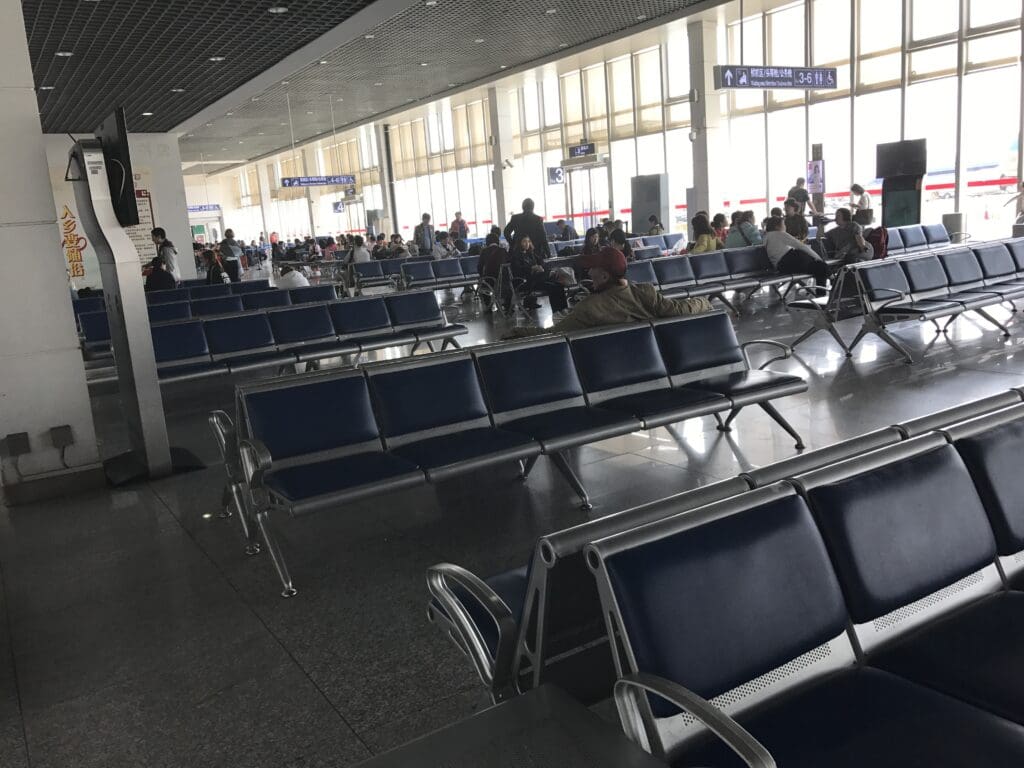

As time passed, the terminal became increasingly crowded and I suspected that the flight over to the Middle East would end up being rather full, with most passengers appearing to be tourists from China, many of whom were travelling as part of several large tour groups. Meanwhile, I noticed four new crew members – two pilots and two flight attendants making their way over to the aircraft, whilst the rest of the crew appeared to consist of those who had boarded in Shenzhen.
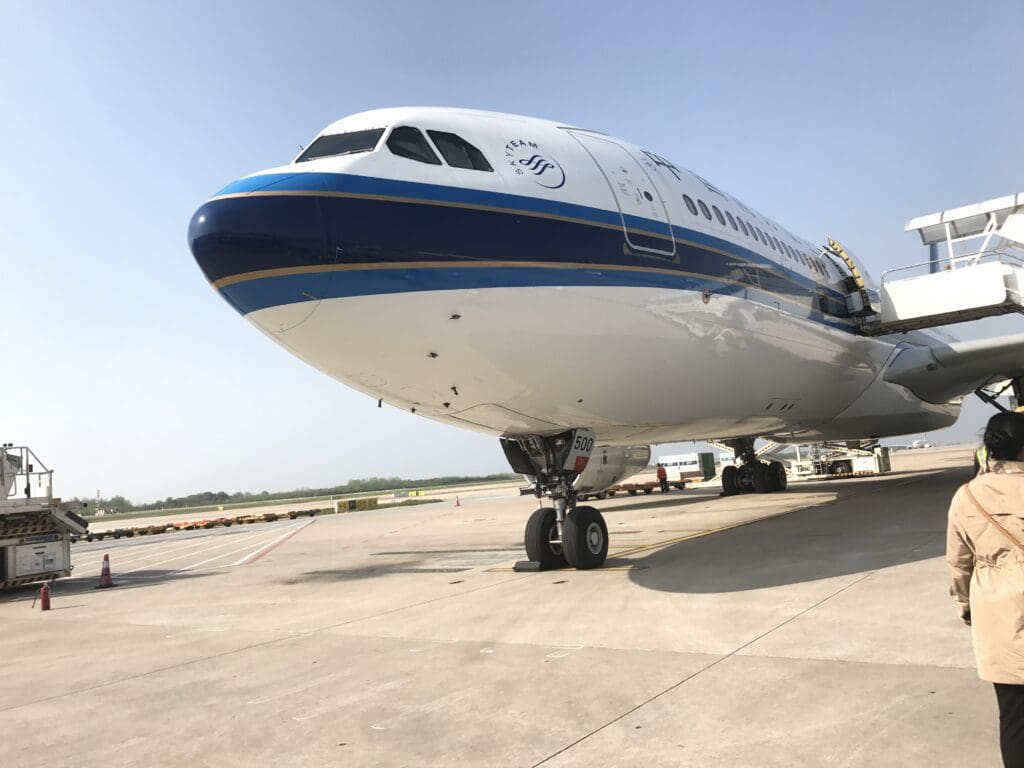
Eventually, the time came to board the aircraft and once this was announced, a messy scrum of passengers formed around the gate podium. Joining this, I soon had my boarding pass scanned and passport checked before I squeezed onto the first bus for Economy passengers. After the very short journey, I arrived back at B-6500 and upon disembarkation, many passengers posed for photographs in front of the aircraft, something that the multiple security guards seemed to have no problem with. After a short queue I stepped into the aircraft where I was greeted by the same two crew members that had welcomed me aboard in Shenzhen before I turned right down the second aisle and made my way back to my seat.
As I had expected, the aircraft had been cleaned in Wuhan, whilst being a long haul service, blankets and pillows had been placed on each seat, accompanied by headphones in the seatback pocket. Once the second bus arrived at the aircraft, the cabin filled up and after a third bus, all had made it onto the aircraft. As I had expected, the flight appeared to be virtually entirely full in Economy. Looking around, many of those around me seemed to be first time flyers and the crew had quite some difficulty in getting everyone settled and the cabin secured for our departure. Once all were finally seated, the Purser performed their usual announcements and the aircraft was pushed back away from its stand before the two Rolls-Royce engines on either wing powered up into life ready to transport us all to the Middle East. After the two engines had spooled up, the Airbus commenced what seemed like a long taxi to the runway, during which I caught brief glimpses of two retired Boeing 747-200 Freighters that were once operated by the locally based Uni-Top Airlines.
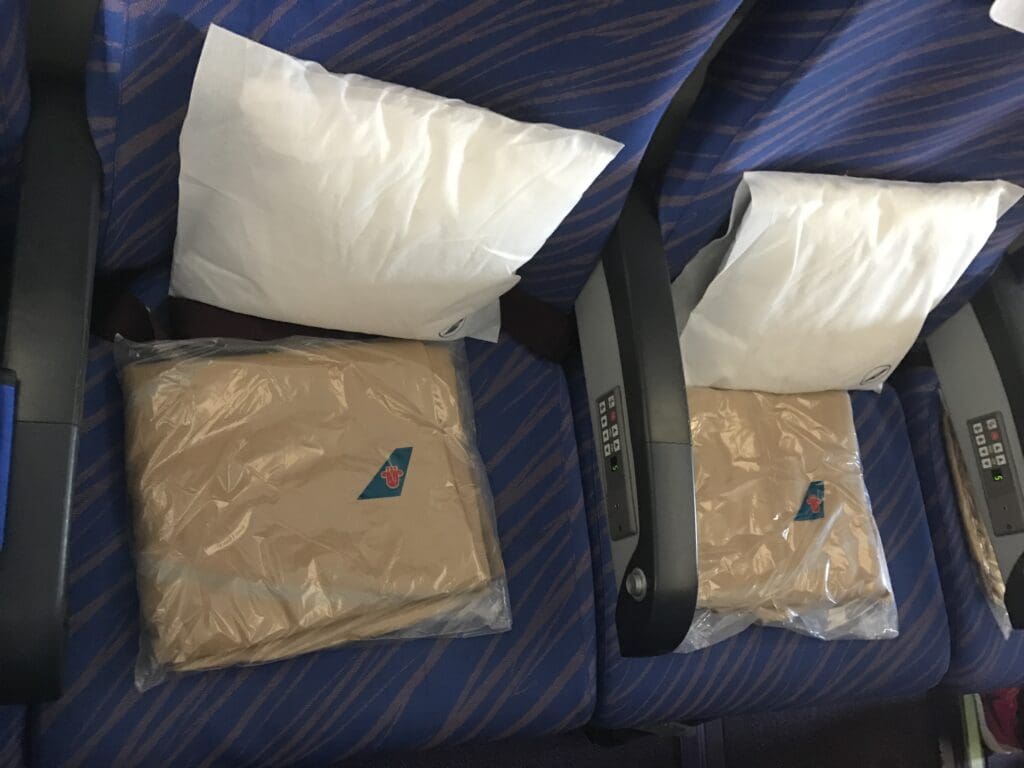
After another seemingly less than powerful departure, the aircraft headed westwards and once we had levelled off at our cruising altitude, the meal service commenced. This commenced with the distribution of wet wipes and a round of soft and hard, and hot and cold drinks before our late lunch was handed out around forty minutes later. That afternoon two options were on the menu – Chinese style chicken or Western style fish. I opted for the former and was presented with a chicken and rice dish served with a salad, a cream based dessert and butter (although no bread was offered with this!). This was most certainly far from the worst inflight meal that I have ever had, and most certainly filled a gap, leaving me with relatively few complaints. Around half an hour after I had been handed the meal, the crew passed through the cabin collecting trays, whilst requesting those in the window seats to close their window shades before the cabin lighting was turned off.
With little to do, I decided to turn to the inflight entertainment on the Airbus’ overhead screens. This commenced with two Hollywood films, Collateral Beauty, followed by Hacksaw Ridge. Unfortunately, the latter was cut off half way through at which point the film Rogue One was played on repeat until the overhead screens were retracted in preparation for the aircraft’s arrival. With the cabin plunged into darkness, most passengers appeared to fall asleep, and, on no fewer than two occasions a late middle aged passenger several rows ahead stood on their seat and attempted to retract the overhead screen above them, pushing this upwards only for this to automatically fall back down seconds later. Appearing to get somewhat annoyed by their futile efforts, they eventually gave up. As time passed, many in the cabin seemed to wake up and there was a rather light hearted atmosphere with many of the passengers in the holiday mood, standing up and chatting to their co-flyers or playing cards to pass the time.
Around two hours before landing, the cabin lights were turned on at full blast, waking up any of those passengers who had been asleep and hot towels were handed out. Several minutes later, trolleys were rolled out into the aisles and passengers were offered a second meal. Eventually, the crew reached my row and I was offered noodles or rice. Choosing the latter dish, this consisted of noodles in a sauce, and, in a breakfast style this came with some watermelon, a yoghurt, a tub of orange juice and a croissant. This seemed like a slightly odd choice of sides seeing as it was early evening in Dubai and the middle of the night in China. However, I could hardly complain and once again I found the quality of this to be fairly decent.
Once my tray had been collected, I drifted off and before I knew it, the crew were announcing the closure of the toilets in preparation for the flight’s arrival. Talking of these, I found the toilets to be stocked with basics, although their condition seemed to get progressively worse through the flight and ended up in a rather unpleasant state by the time of my final trip to these. By this point in the flight, my cold had worsened and I was constantly wiping my nose – rather kindly, my neighbour had noticed this and had given me a small pack of tissues. Eventually, the aircraft sank down towards Dubai before finally making a soft touchdown and commencing a long taxi to Terminal 2. After pulling into the gate, disembarkation commenced fairly quickly and once off the aircraft I began the long walk to the train station before catching the automated train over to the arrival hall. Unfortunately, once here I was met with the sight of long queues, although these did move along at a reasonable pace. All in all, I made it to the landside area within around an hour of touching down and soon found myself in a taxi heading towards Dubai Marina, ending my journey far more tired and a day later than I had expected.
Return Trip
My return journey back to Korea went somewhat more to plan, although this was not without several glitches. Somewhat regrettably, suffering from a bad cold, I opted against writing reports from these flights.
To start with, I had to spend a good five minutes convincing the check-in agents in Dubai of the validity of my Korean identity card. Following an uneventful overnight flight back to Guangzhou onboard a much more modern personal inflight entertainment screen-equipped SkyTeam liveried Airbus A330-200, for the first time in my life I had to queue jump the massive queues at immigration in order to enter China, otherwise I would have missed my onward connection to Beijing. Meanwhile, once in Beijing I fell victim to air traffic control delays once again and my Korean Air Boeing 777-200ER flight back to Incheon ended up departing over an hour late.
Adding a memorable ending to my long weekend away, when I arrived back in Incheon, I answered the health questionnaire with full honesty. This honesty meant that given my cold, I struck fear in the hearts of the airport quarantine workers who whisked me away after arrival to the airport’s health centre on suspicion of contracting MERS. Eventually after about an hour of questioning, multiple temperature takings and numerous phone calls to healthcare professionals I was released and headed to immigration when only one officer could be found manning the passenger-less Korean border. After asking me where I had come from as there had been no arrivals for over an hour I told him my story which he seemed to find slightly amusing.
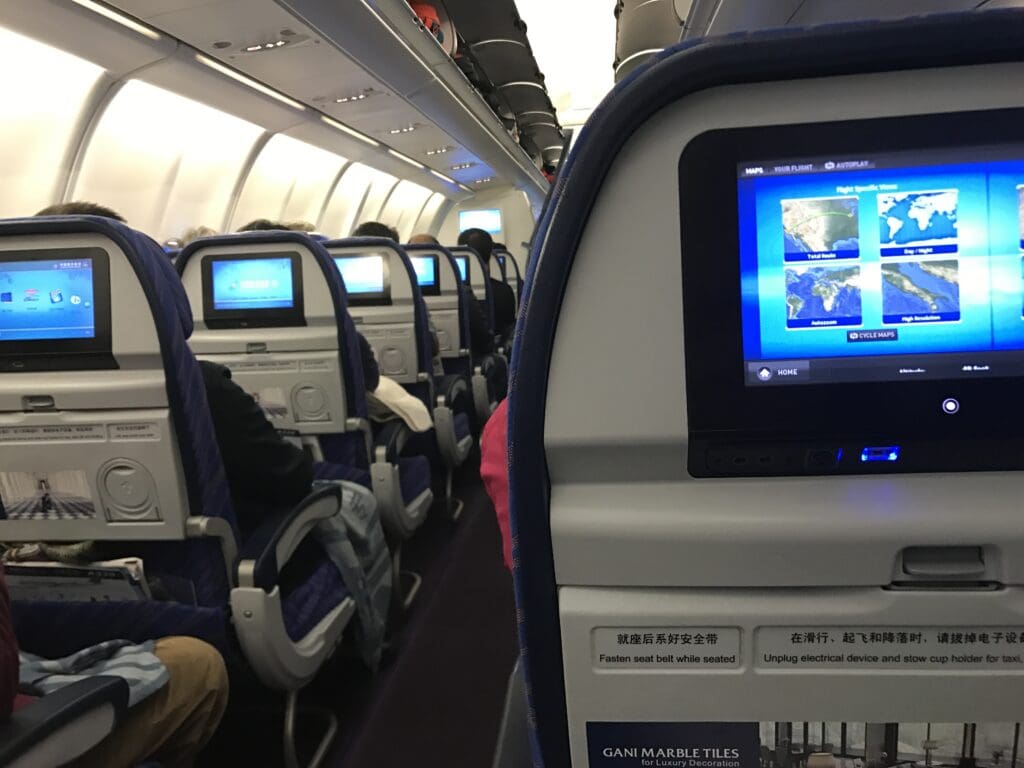
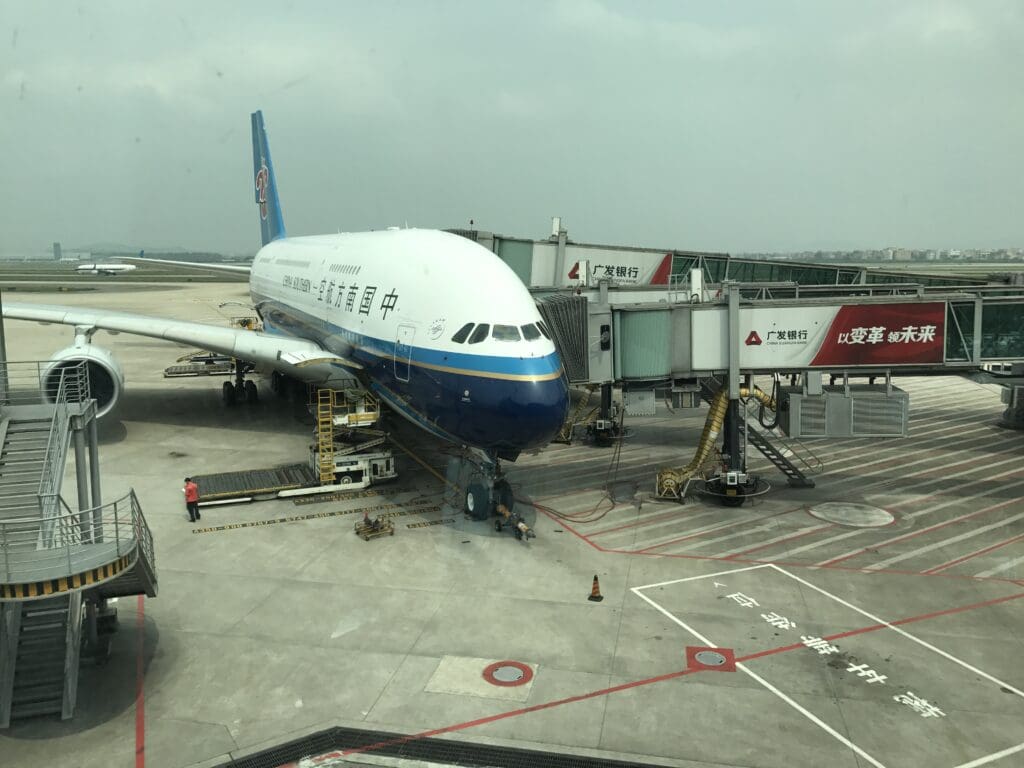
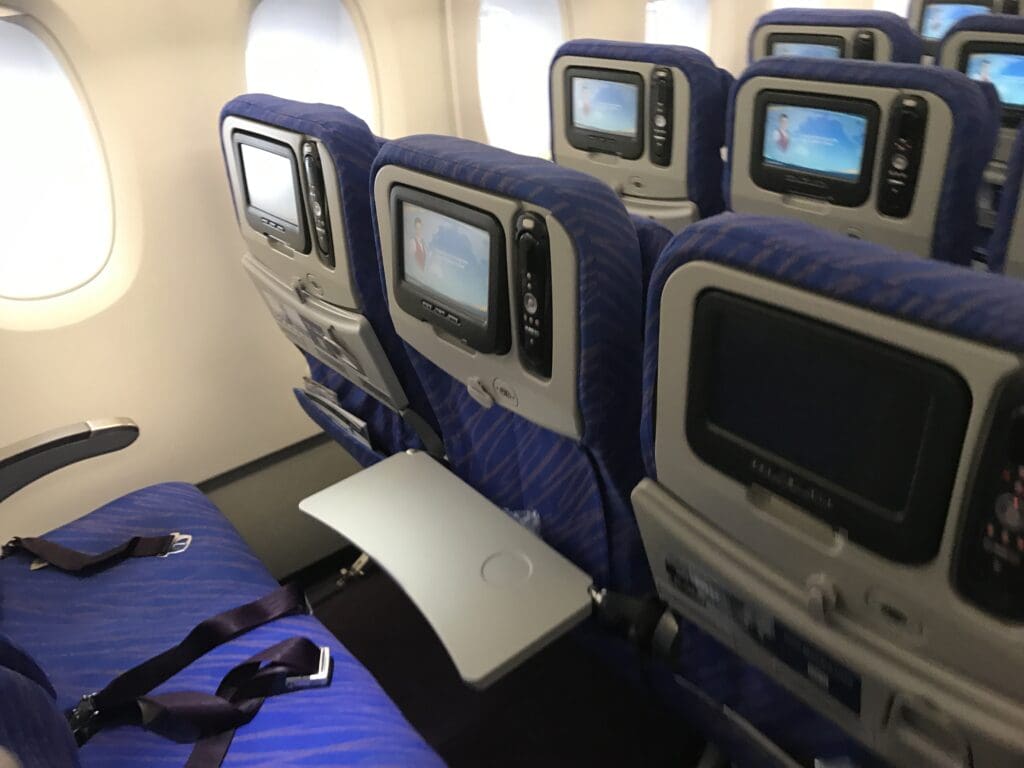
Summary
Had nothing gone wrong, judging by my onboard experiences on this trip, I would have likely labelled China Southern Airlines to be simply mediocre. On all flights, the seats were of acceptable comfort and whilst not being anything special, I found each aircraft’s cabin to be clean and in a reasonable state. However, some may complain about the lack of inflight entertainment screens on the long flight from Wuhan to Dubai. Turning to the food, this was decent, yet nothing particularly memorable, whilst on all legs I found most crew members to be cold and distant. However, of course, my experience with China Southern was heavily tainted both by the fiasco several days before this trip as well as the poor handling of my delay. It is worth noting that upon complaining about this after my trip, I was offering nothing by means of compensation for the near 24 hour delay.
In the end, my experience with China Southern Airlines on this trip really put me off flying with the airline again. Other than an unavoidable hop from Beijing to Xi’an a few months later, I steered well clear of them for seven years until trying my luck with them once more. This time flying from London Heathrow to Seoul Incheon via their new hub at Beijing Daxing, with these flights operated by an Airbus A350 and an Airbus A321 respectively. Whilst a report will follow, overall the airline seemed to have improved massively during this time.

